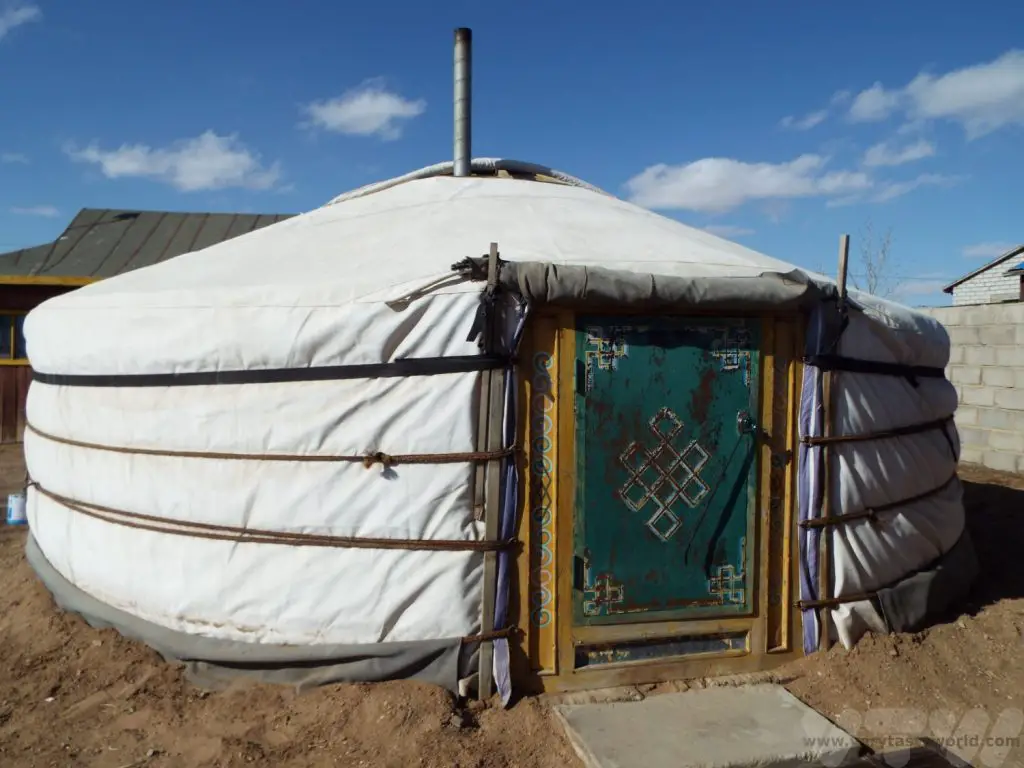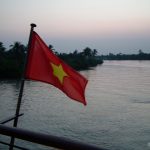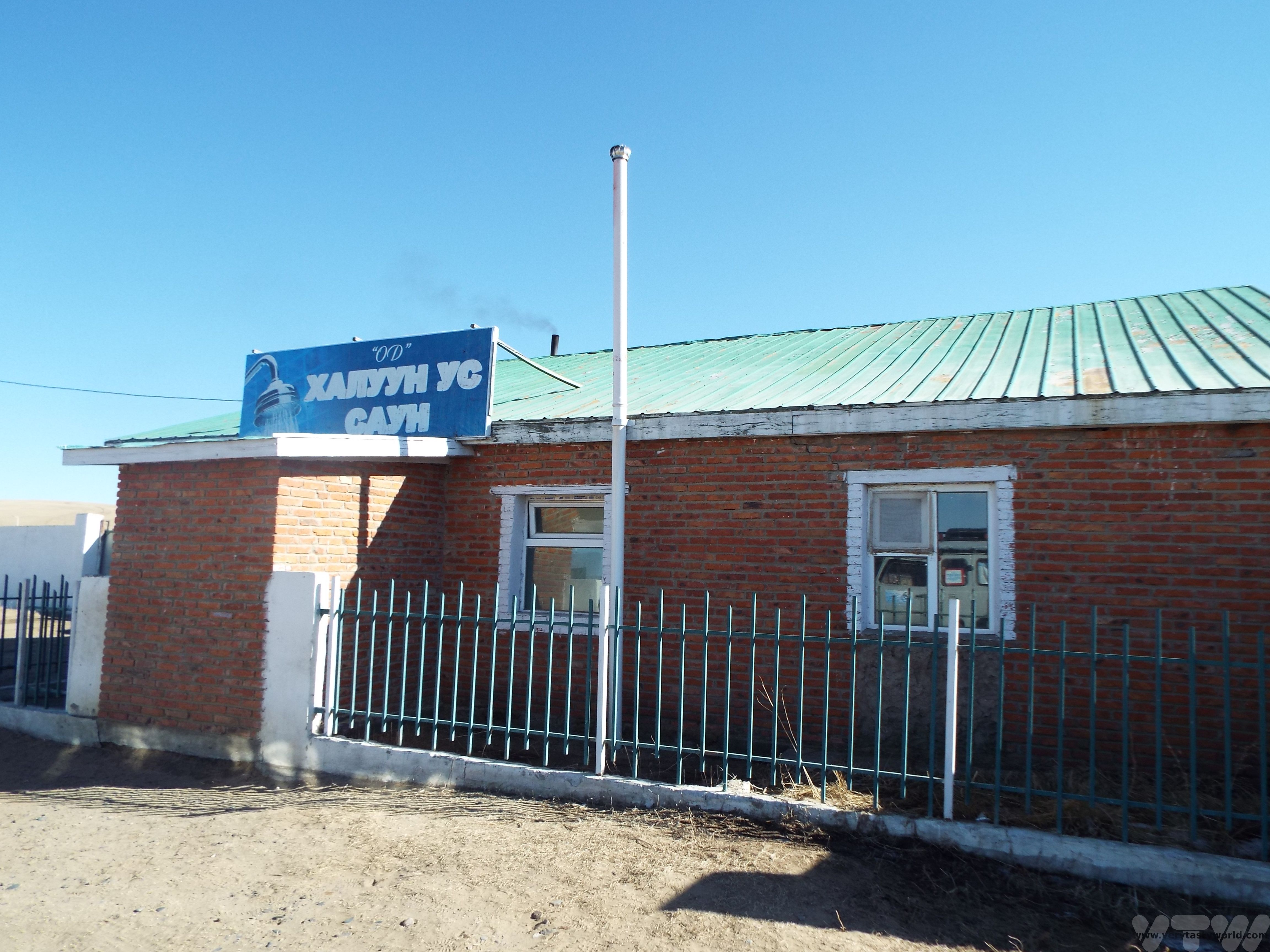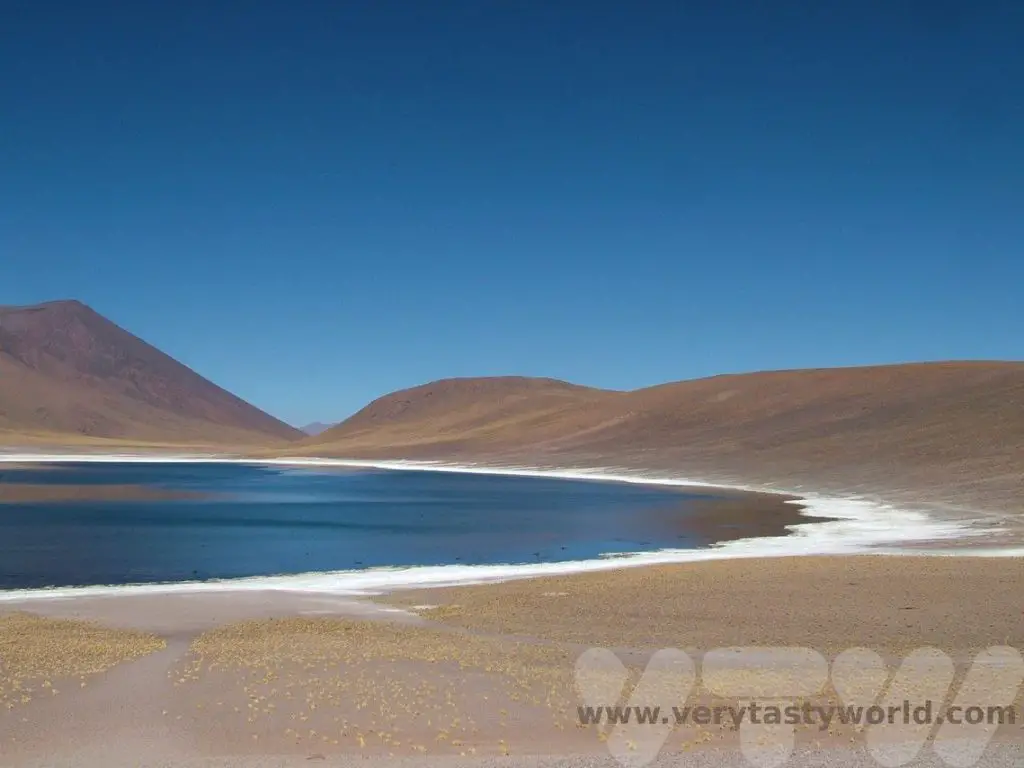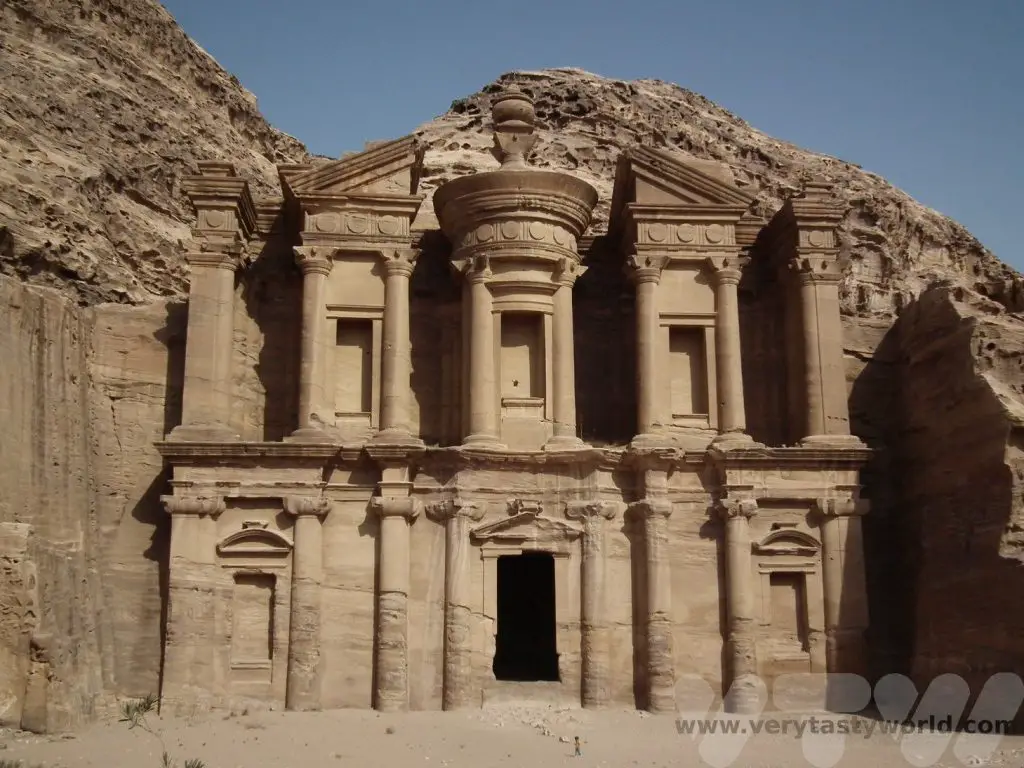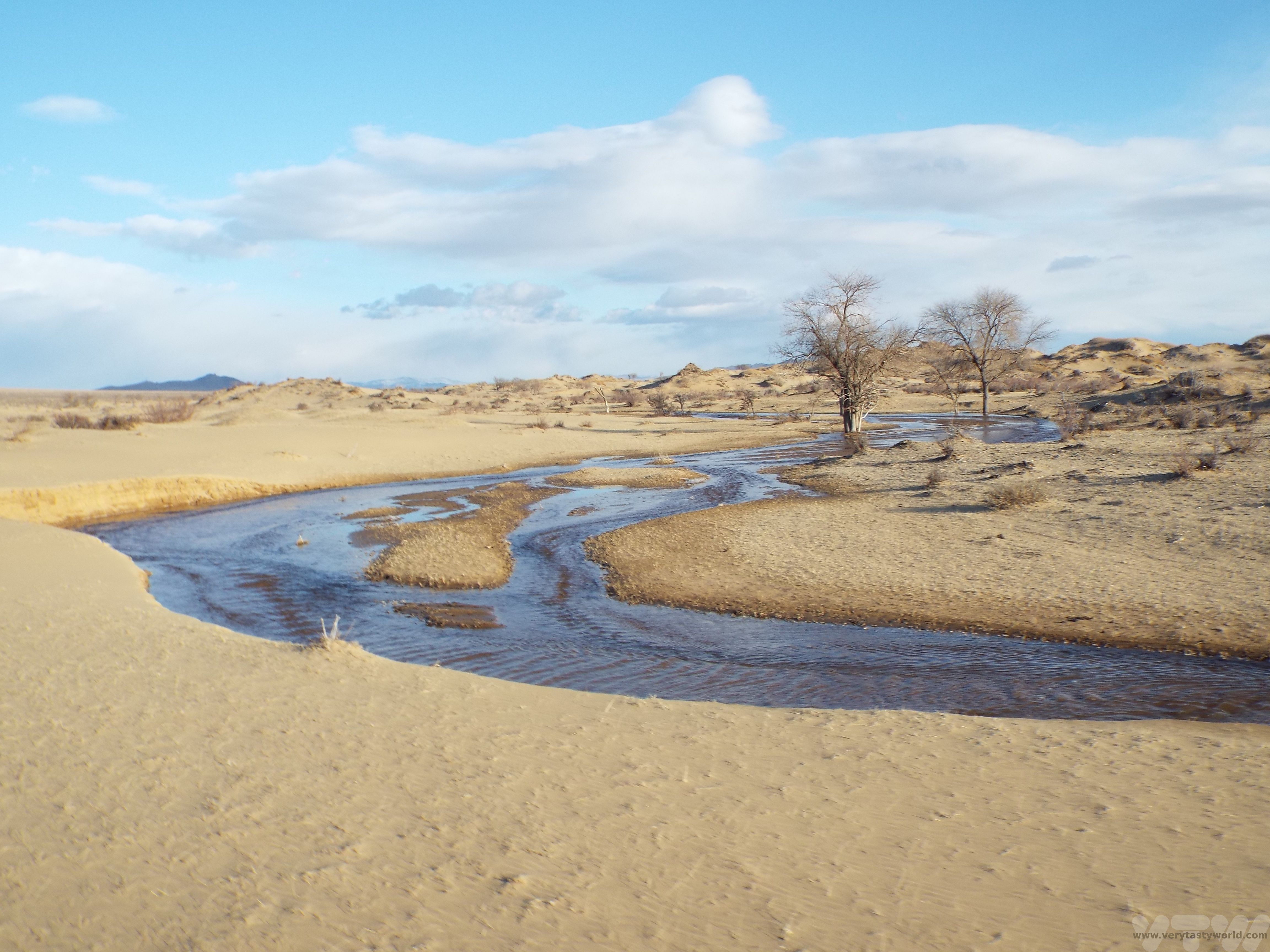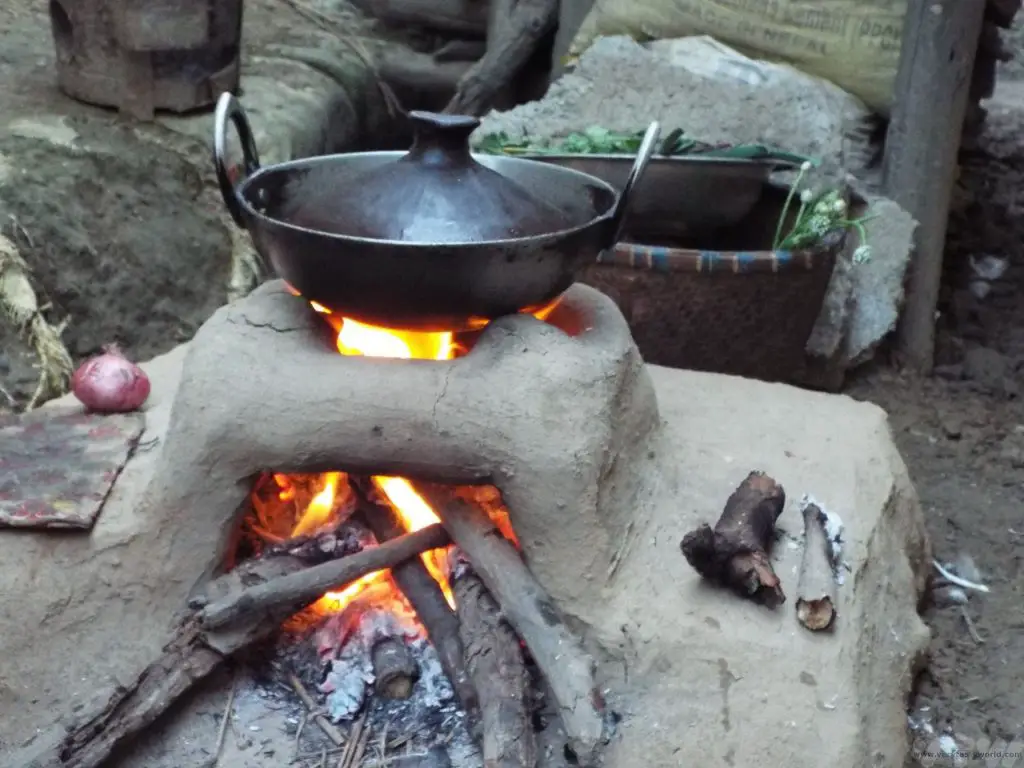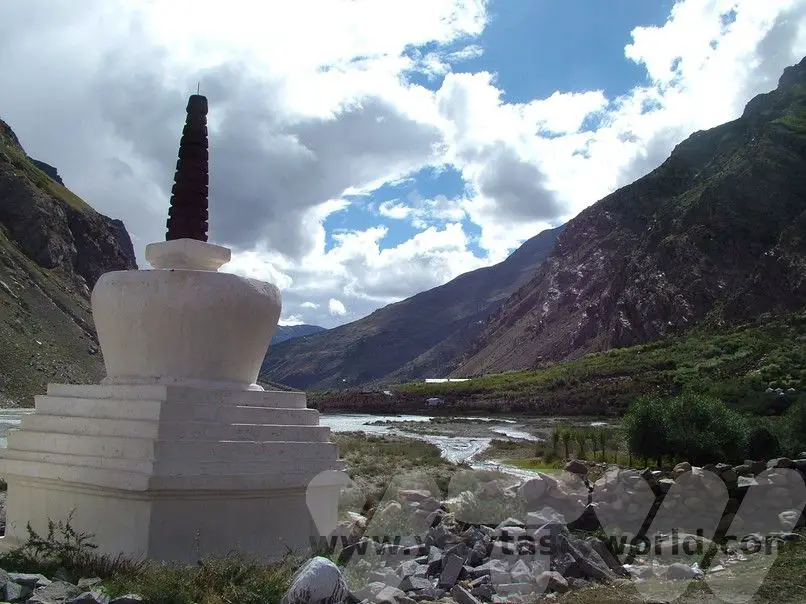Showers? Where We’re Going We Don’t Need Showers… Adventures in Washing in Mongolia
Mongolia is the place to have adventures: to go far, far off the beaten track, see marvellous landscapes, meet wonderful people and, in some ways, to challenge yourself. Washing and taking a shower in Mongolia is a very different experience to normal washing in our home country.
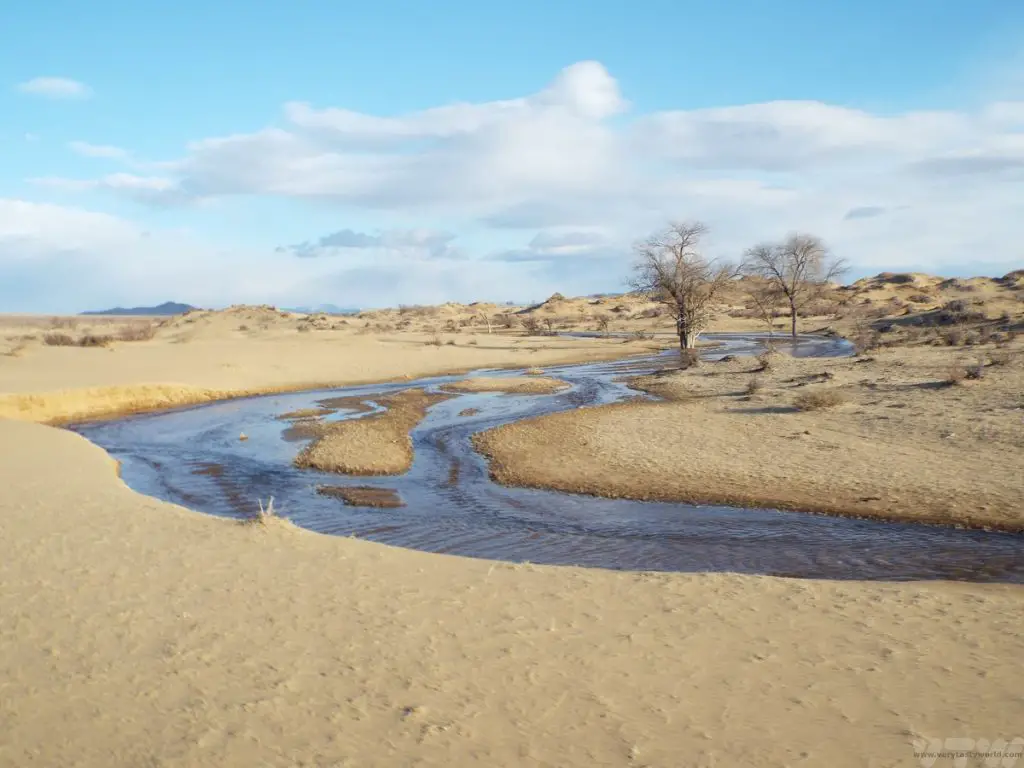
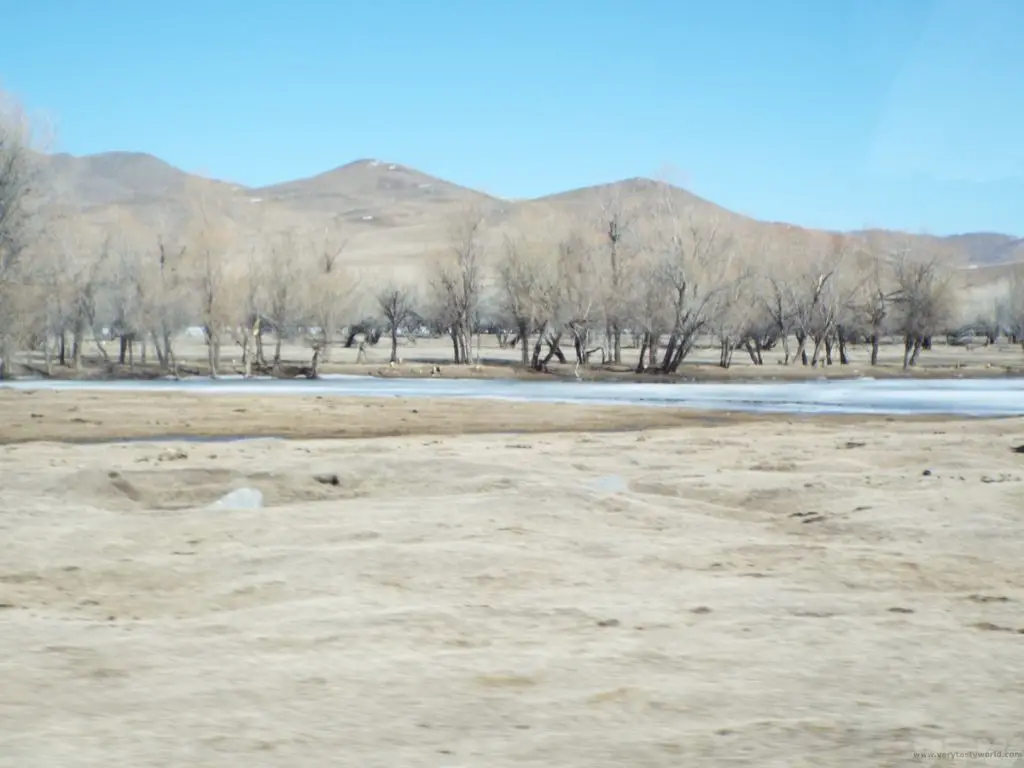
Please note that this post contains affiliate links. If you click through and decide to make a purchase we will make a small commission, at no extra cost to you, which will help towards the costs of running this site.
We’ve never particularly been interested in luxurious travel – we feel a bit uncomfortable about having our bags carried for us and we really don’t need lashings of extras in our accommodation – a bed and a bathroom will be just fine.
We were quite surprised on a recent trip where we got upgraded from a 3 star to a 4 star hotel in the UK that the difference between these levels of comfort really boiled down to a trouser press and significantly more useless cushions (which all needed to be discarded before trying to sleep) on the bed to make it appear more inviting.
We’ve been lucky to have travelled to many places all over the world. It was on a trip to Bulgaria many years ago that we first learned that some countries don’t have the drainage infrastructure to allow you to place waste toilet paper into the toilet itself so you have to use a bin instead.
This really made us think about how we live and helped us realise how lucky we are that we live in such comfort – where we can flush a toilet, or wash ourselves simply by turning on a tap.
Staying In The Gobi Desert in Mongolia
We knew that when we were staying in gers (the Mongolian name for yurts) with nomads in the middle of the Gobi desert a beautifully plumbed-in bathroom was not going to be available. In the middle of a vast desert it is obvious that there is no running water except in some of the larger towns where it would be possible to get a shower in Mongolia.
We were very aware that when we booked our trip, we were going to have to get used to not showering every day and also that the toilet arrangements would largely involve squatting over a hole in the ground. This was the loo in the Gobi.
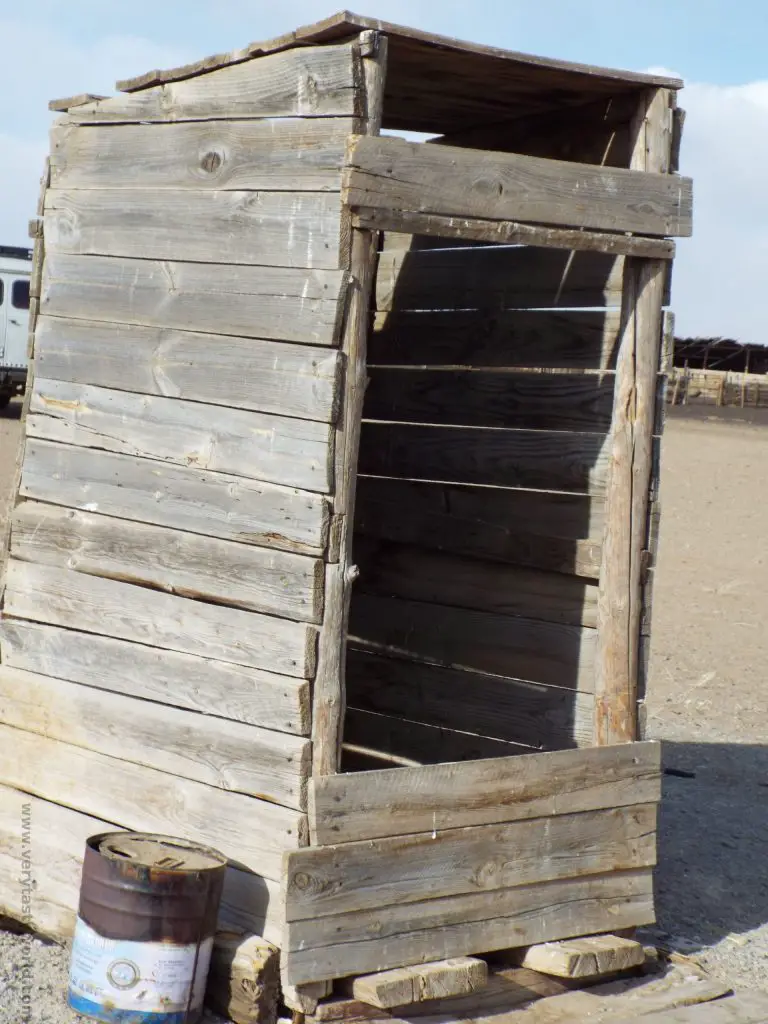
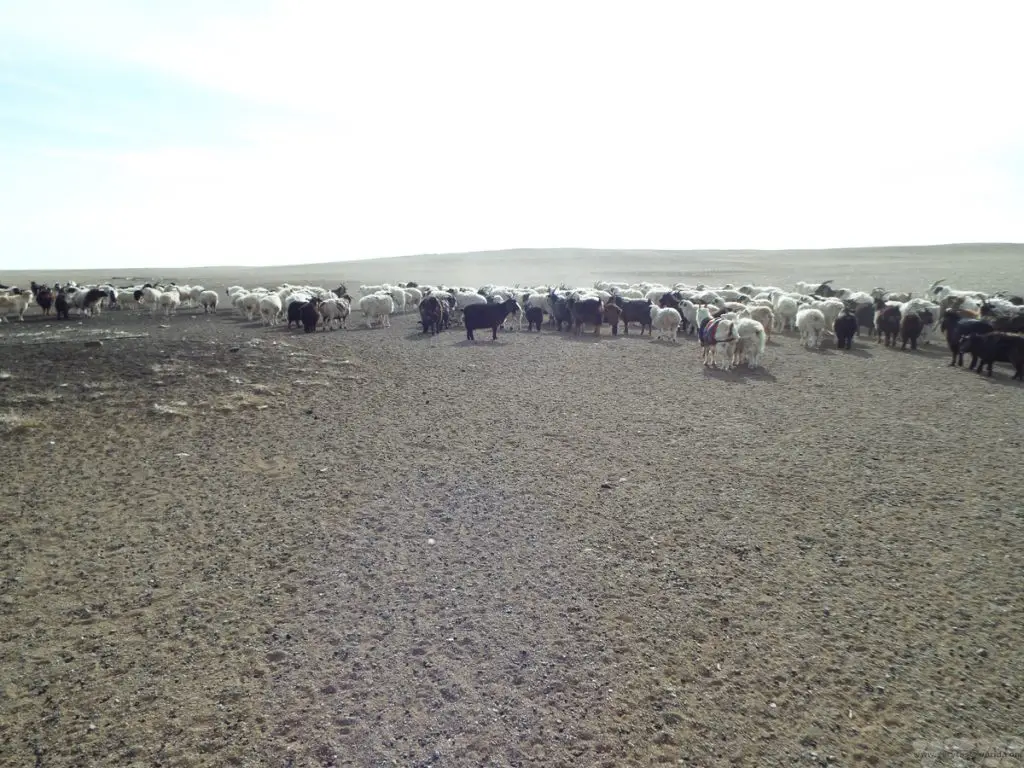
It had a good view, though.
In the Gobi people use a well to obtain water.
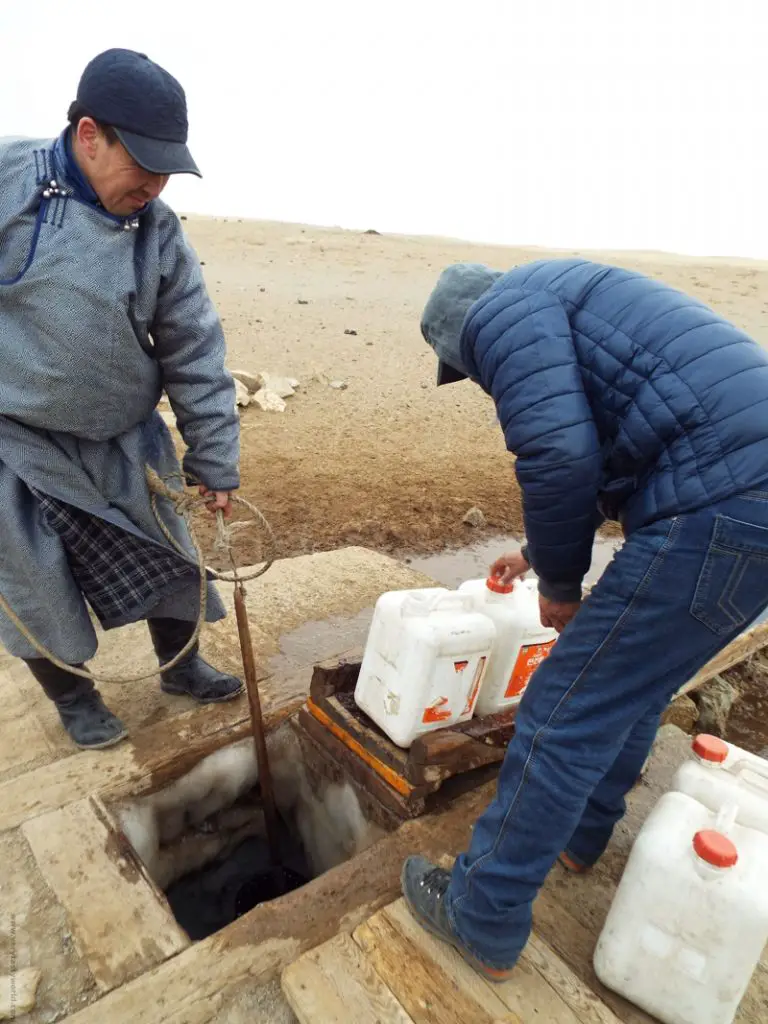
Sleeping In A Ger
You are always conscious of how precious a resource water is. You don’t waste it. Whether we were staying with families who had kindly shared their homes with us or in ger camps, water was always available, but it was finite, stored in a barrel in the kitchen area.
In family gers there is a wash area to the right side of the door and many have a little water container located above a sink area which has a tap. You run it for a minimal time to get just enough water to wash your hands or clean your teeth.
In tourist ger camps, there wasn’t always a basin inside but there was often an outside communal area where a sink had been set up between the gers where it was possible to have a quick wash/teeth clean.
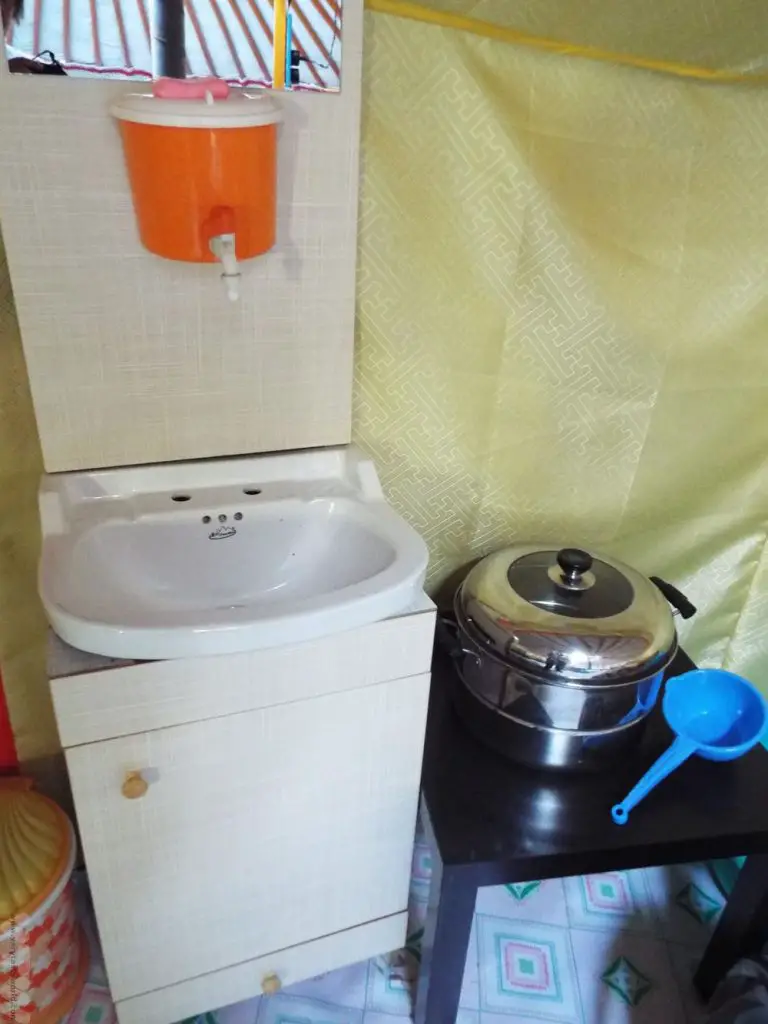
It’s not unfair to describe Mongolia’s climate as extreme with the vast temperature differences it experiences across the year. A landlocked country, with a continental climate, temperatures in the Gobi can range from -30⁰C in winter to 40⁰C in summer. It is also very dry, which helps mitigate the impact of these extreme temperatures, and usually has around 250 sunny days each year.
We visited in early spring when temperatures were still largely sub-zero – around -15⁰C at night, rising to 0⁰C during the day. Curiously, because the humidity was so low these temperatures didn’t feel as cold as they should. Likewise, the dry summer heat would be more bearable than, say, the humid climes of south east Asia or central America. But, of course, you do still need to wash.
Sanitiser gel and wet wipes (environmentally sound, non-plastic ones) were useful. But with wet wipes you do need to dispose of them properly. Indeed, waste disposal is a problem in Mongolia, so we always carried our rubbish with us until we reached a public bin where we knew it would be collected. (Not all that is ours!)
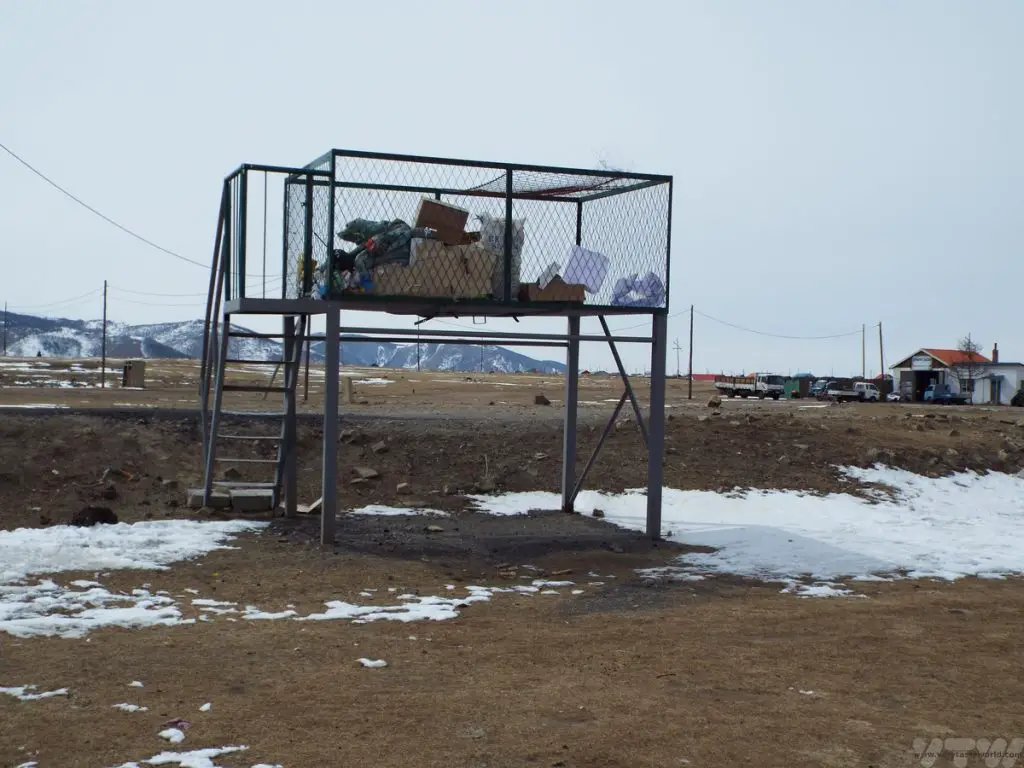
Where To Get A Shower In Mongolia
We had about three showers during our eleven day trip. Not washing and having greasy hair is surprisingly liberating – much more than we ever thought it would be. But how do you get a shower in Mongolia? You do what the locals do and go to a shower house. These are usually located in the larger towns.
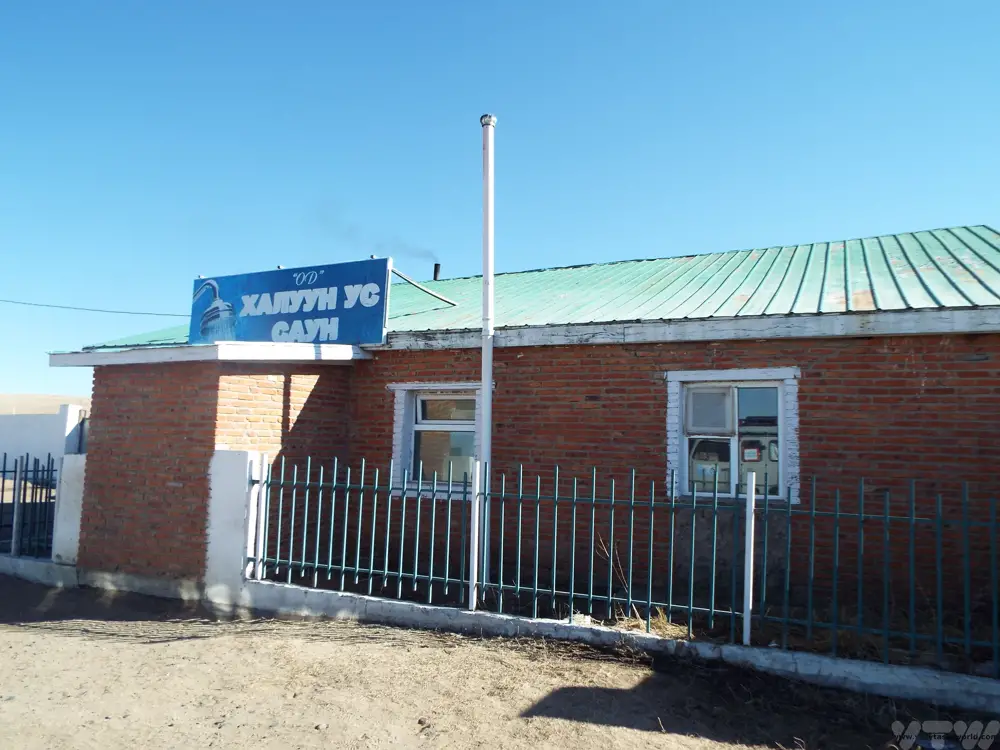
For a small fee you can use a shower room, with hot running water, either on a family/couple basis or hire an individual shower. There is a usually a changing room adjoining the shower room itself. We brought our own towels and toiletries (just soap/shampoo) with us. Because we were travelling at the end of winter we could walk straight in but during the summer months you may have to queue on a first-come, first served basis. They are basic but entirely functional.
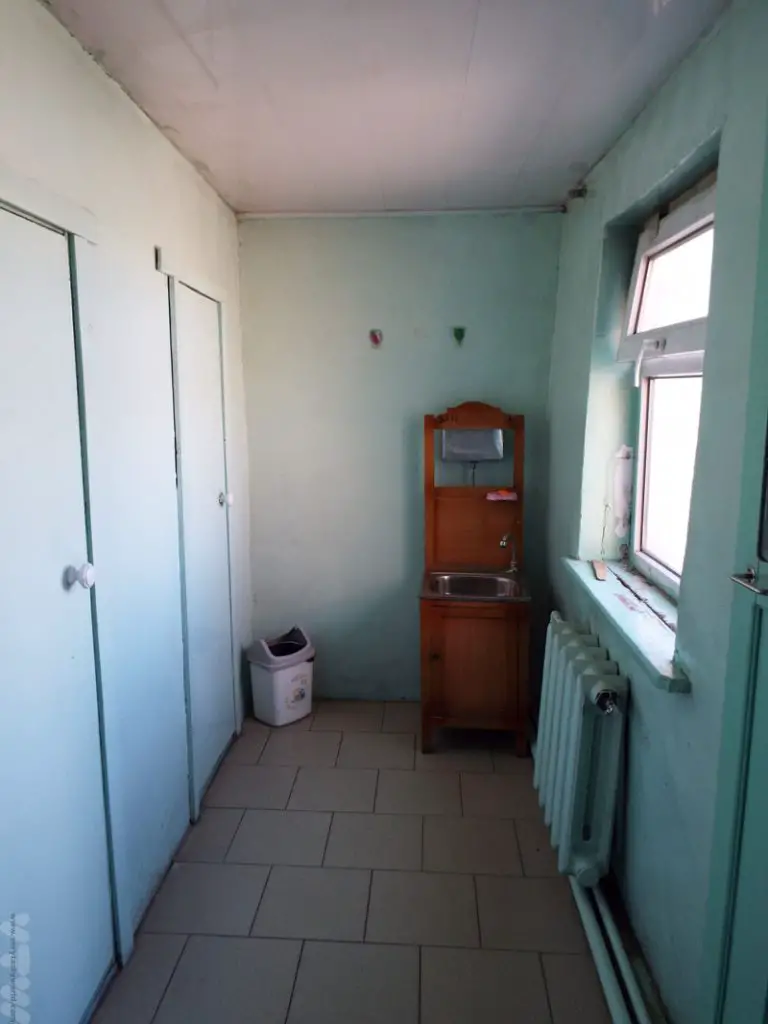
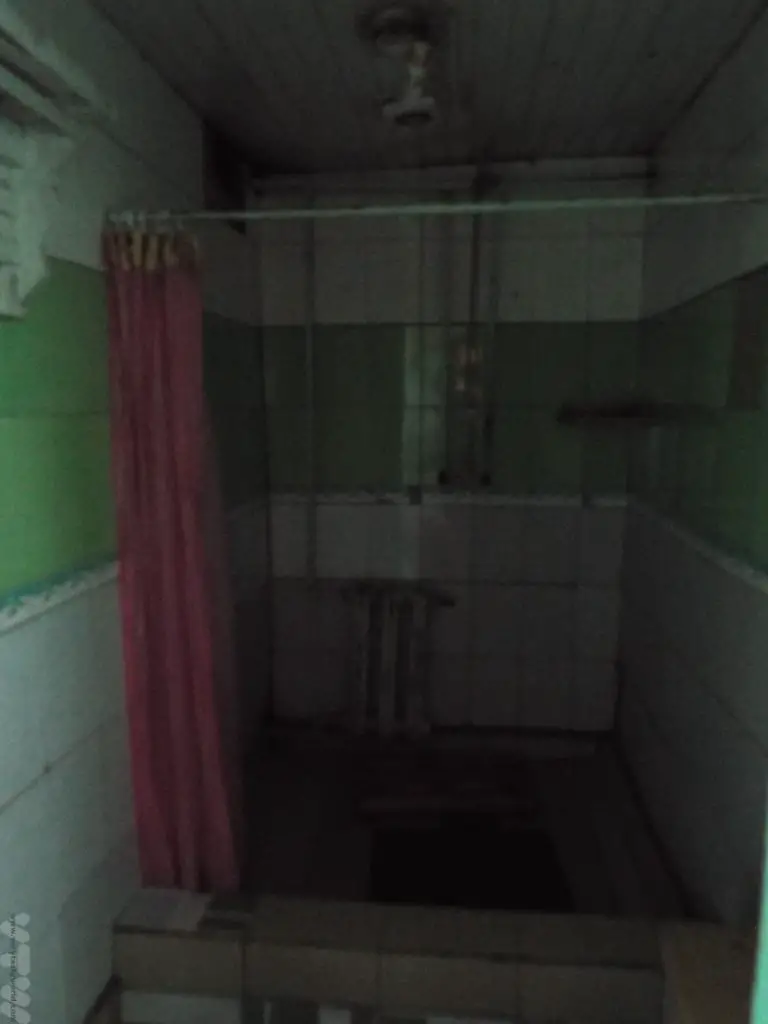
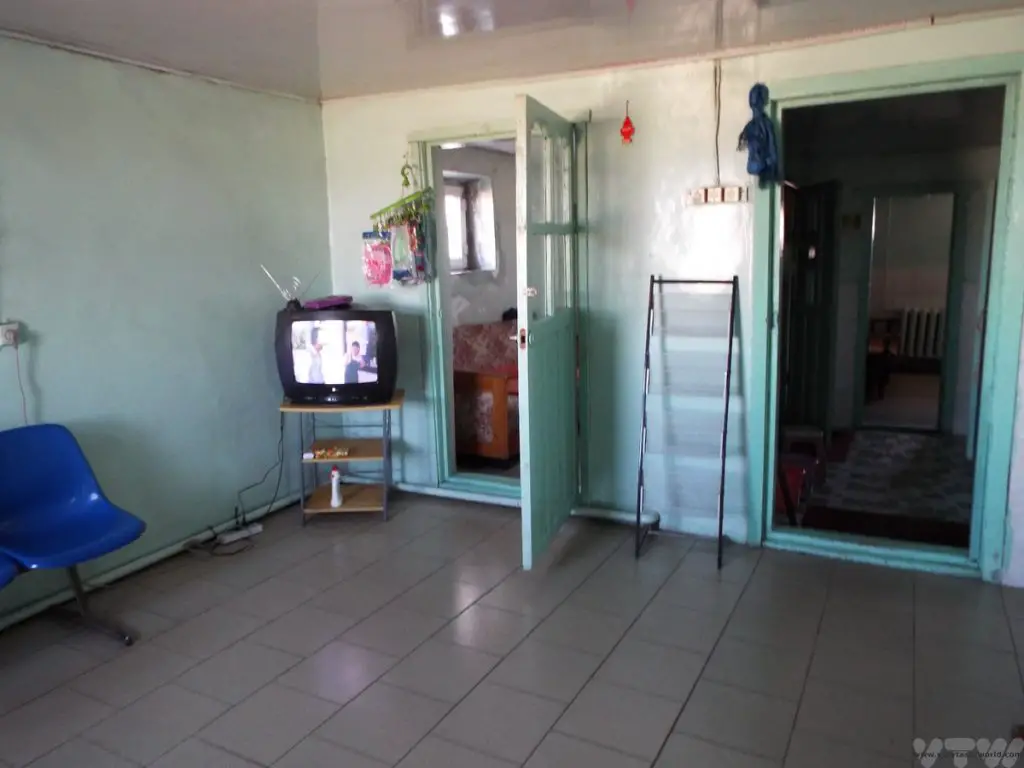
Packing Essentials For A Shower In Mongolia
For Shower Days
Travel towels – if you manage to get a shower in Mongolia microfibre towels are best. They dry you quickly and they dry quickly after they’ve dried you. If you’re staying in a ger, you can hang your towel from the rafters to let it dry. We found that our hosts often used the rafters for hanging out their washing, or as a coat stand. You can get a variety of travel towels that squish nicely into a bag.
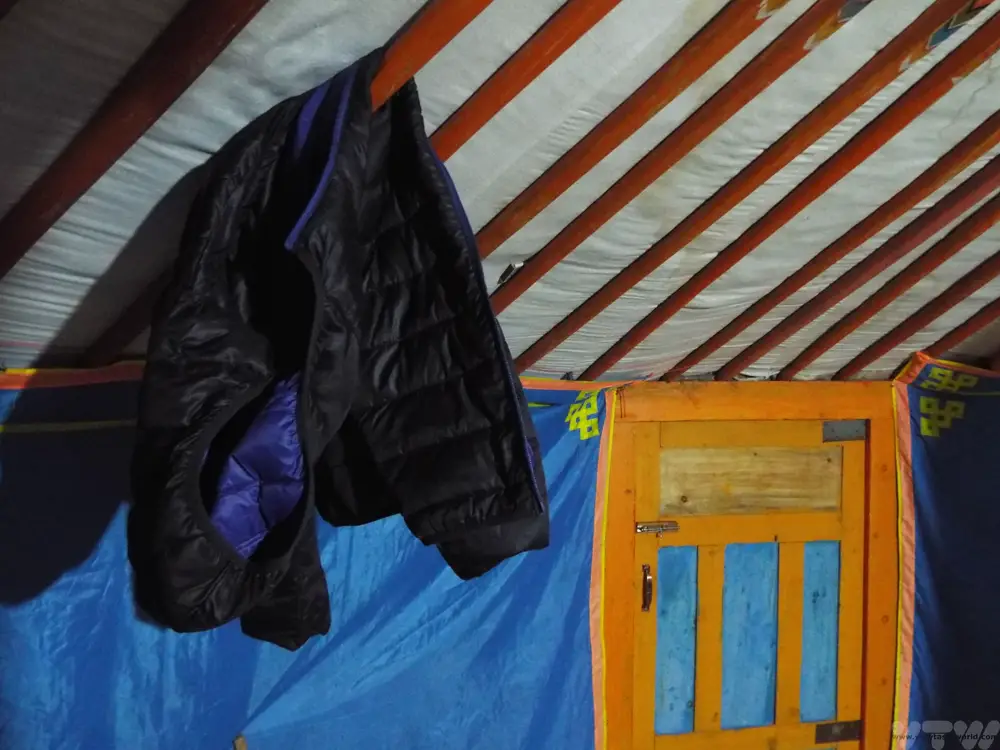
Basic toiletries – We tend to use products that combine body and hair wash. If you’re not sharing a shower room, you’ll need one for each person, or wait until your companion has finished washing.
For Non-Shower Days
Wet-wipes – useful for a ‘lick and a promise’ wipe wash. Try to get biodegradable types, if possible. If you can’t, they need to be disposed of responsibly, never to the environment.
Hand sanitiser – once an essential item for travellers, now an essential item for the world, especially helpful for cleaning your hands after answering the call of nature.
General Packing Tips for Mongolia
Deodorant/anti-perspirant – you can get some types that last for 48 hours. Moisturiser and lip salve may also be useful – the cold weather can dry the skin somewhat. Suncream is also a good idea.
Shaving kit if you need/want it. Electric would be best. Make sure you have batteries, you are unlikely to be able to charge a shaver in a ger. Most of the time the only electricity available will be for a single light bulb, often run from a car battery.
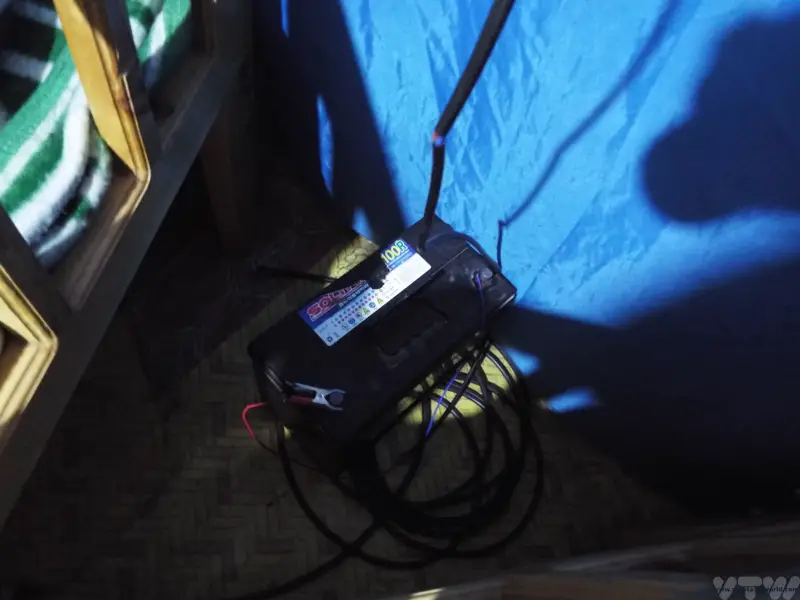
Head torches are really useful, particularly if you need to answer the call of nature during the night. The toilet is usually located a fair distance from the ger so you will need to be able to see where you are going. Using a torch that can be worn on your head means that you have both hands free. USB charged torches are cool but there won’t be a USB charging point in the desert, so you will need a battery operated one. It’s worth remembering to bring a few spare batteries as well.
And, don’t forget your toothbrush. Cleaning your teeth using the water supply in the ger is absolutely fine. The water from the wells is pure and we happily drank it without filtration.
There may be additional toiletries that you will need, in which case bring them along. We tend to bring only as much as we expect to use so rather than take a big bottle, we estimate the required amount and decanted it into smaller bottles.
There are other products, such as dry shampoos, which will wash your hair without water, that you can investigate if you really can’t go without a hair wash. We didn’t bother. Things like towels are necessary but tend to bulk out your luggage and we wanted to travel as light as possible.
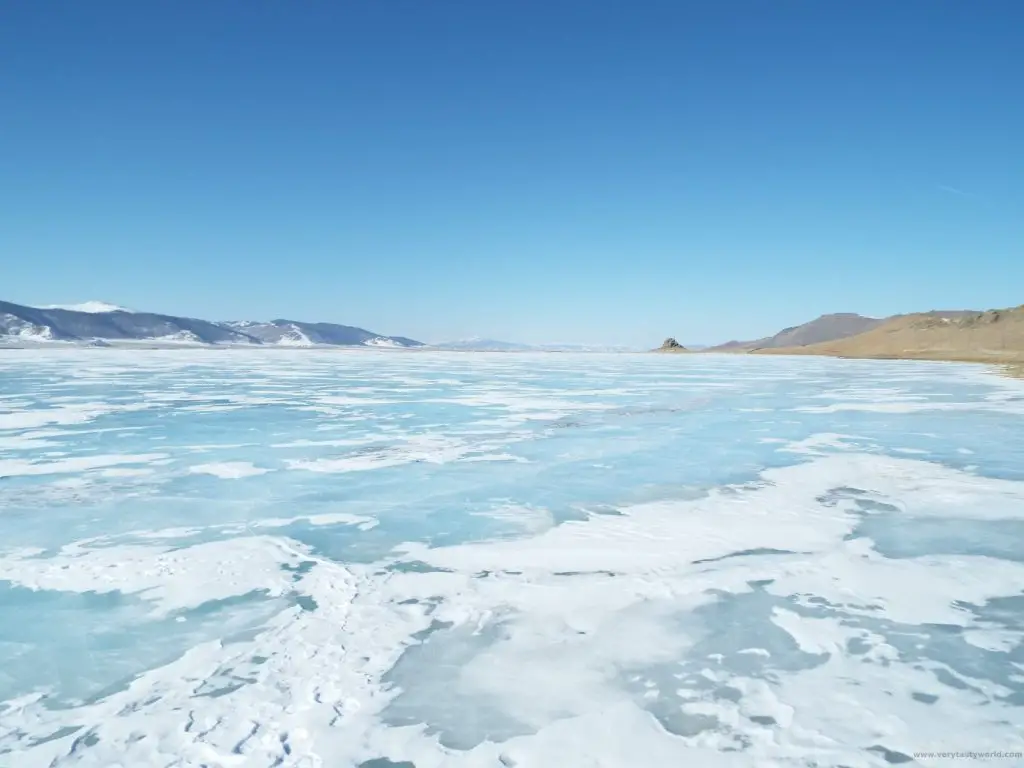
In terms of clothing to pack, we found that layering was a really good idea. You will want to wear socks in bed, along with thermal pyjamas, and as many duvets and blankets as can be squeezed into the van.
It was difficult – initially – to leave our comfort zone and get used to very basic toilets as well as go without washing, but actually we surprised ourselves at how quickly we just got stuck in. We had a remarkable – and hugely enjoyable – adventure.
Related Posts You May Enjoy

Staying With Nomads In The Gobi Desert in Mongolia
A Life In The Day
It was 7am and sunlight was just beginning to filter through the plastic apex at the top of the ger in the Gobi Desert in Mongolia. Outside, the temperature was -15⁰ C. Inside it wasn’t much warmer, the temperature having dropped dramatically since the stove had gone out at around midnight. We were lying in beds, each on the opposite side of the ger from the other, inside sleeping bags and covered with blankets and duvets, just our noses poking out from the abundance of bedding. We hadn’t had a shower for three days. The outside toilet would involve a 50m walk in sub-zero temperatures from the ger to a hole in the ground. Mitch was lying in bed thinking, “What have I done?” Colin was lying in bed thinking, “What has Mitch done?”
This was a trip that was going to be a challenge.
There are some 165,000 nomadic families living and working in Mongolia and they still employ largely traditional farming methods, albeit using modern technology. Sheep, goats, horses, cows and yaks are the most common livestock kept and they are sent out to pasture every day. The nomads may need to relocate their herds three or four times a year and move to pastures new which means that they pack up their housing and all their possessions.
We had travelled from Ulaan Baatar across the vast Mongolian countryside in a Furgon van along roads where tiny Brandt voles would scuttle across from one side to the other and vultures circled in the sky scanning for prey. There were no road signs. Our driver just knew when to leave the road and head across the sparse desert landscape to our destination.
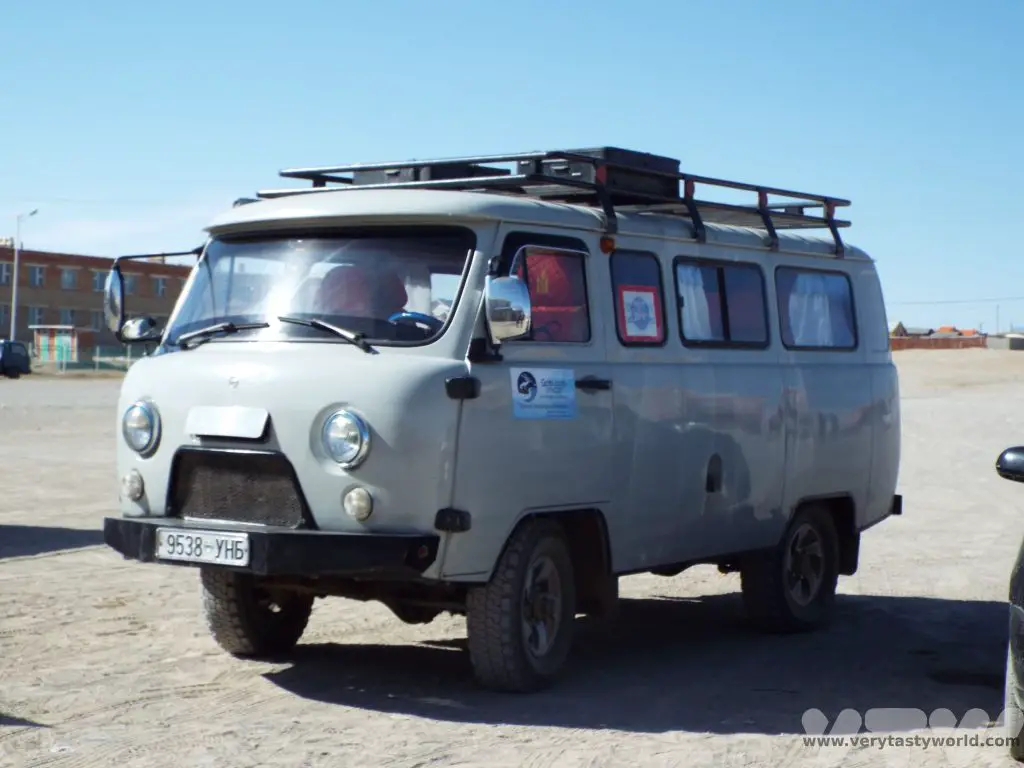
The previous day we had visited the town of Erdenedalai in the Gobi Desert to meet the singing weatherman. The weatherman monitors the location of all the nomadic families in the area and they communicate by radio to warn each other of potentially adverse weather conditions. The map shows the contact details for all the families in the area. The weatherman also has a range of guitars and gave us an impromptu concert.
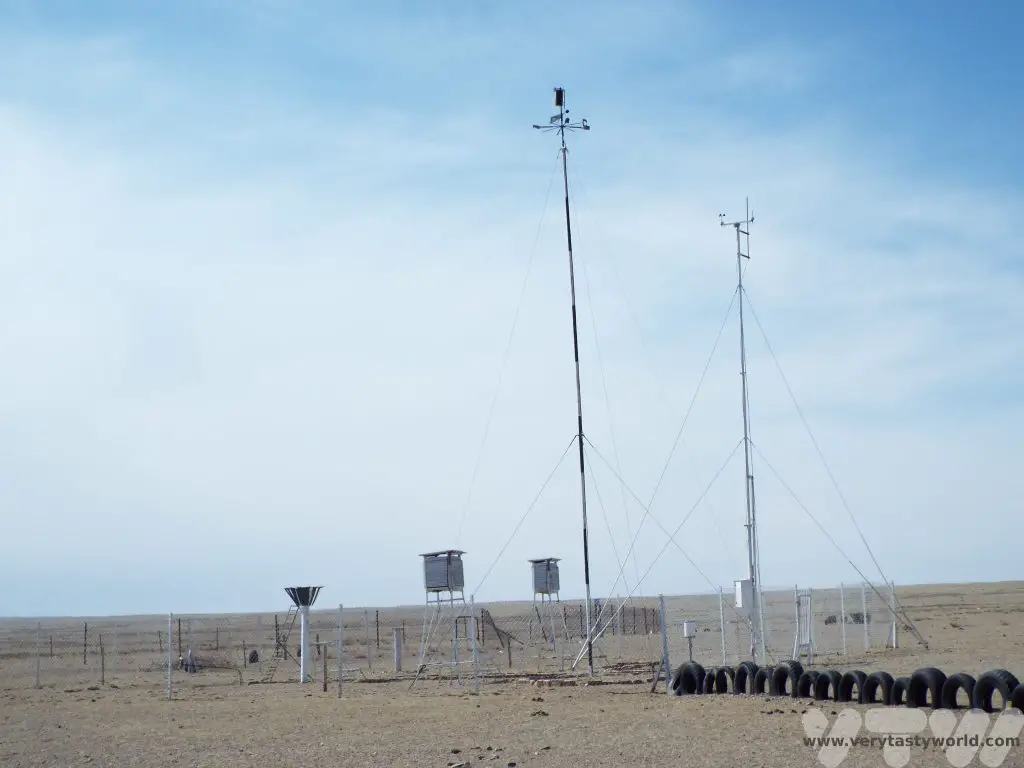
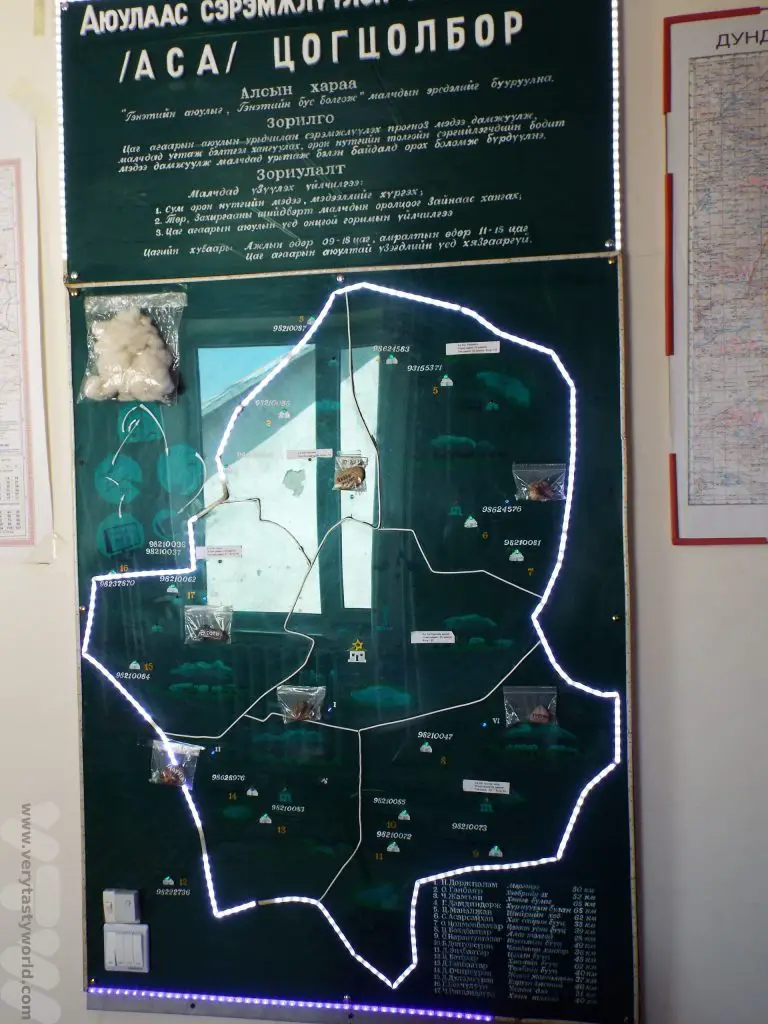
We were visiting Nergui and family who live in the Erdenedalai area, in the middle Gobi Desert in Mongolia. They kept cows, sheep and goats. The wooden pens for the animals are a permanent feature and the family move between different grazing locations several times a year. The gers are constructed alongside the animal pens. They can be taken down and put up in just a few hours – a really clever design.
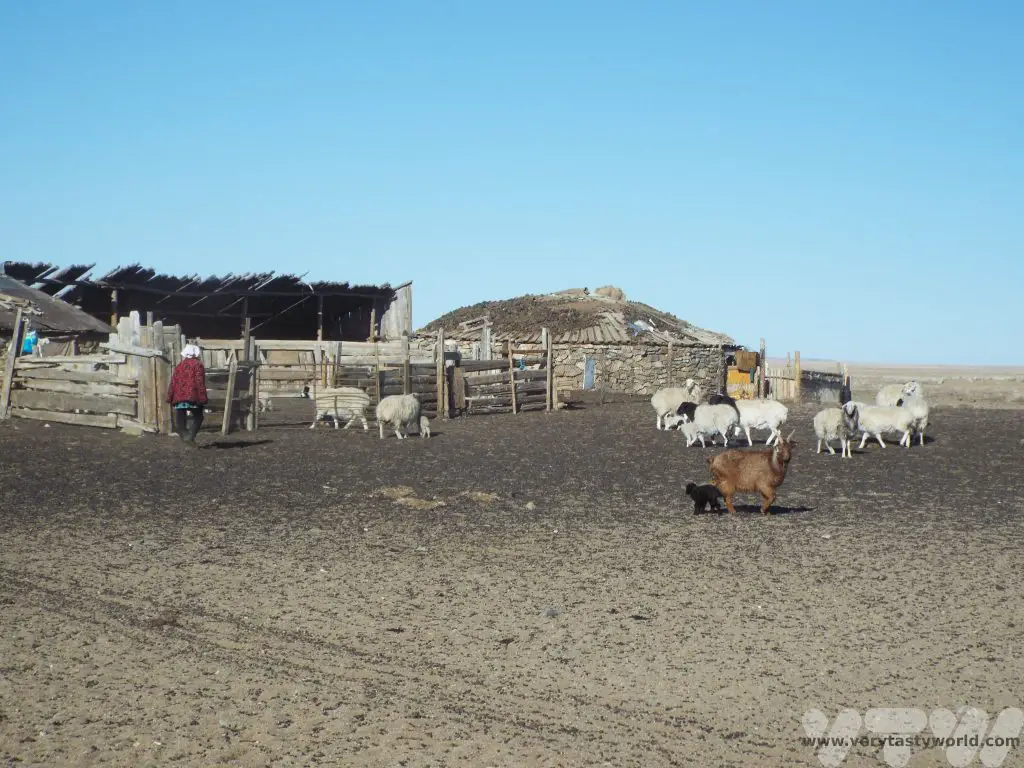
Our hosts had kindly given up one of their gers so that we could stay in their home. Just after 7am, they came in to start the fire. After a quick breakfast we offered to help with the family’s chores. First of all, the sheep and goats needed to go out to pasture. We were visiting in early springtime and many lambs and kids had been born over the previous few weeks. The youngsters were too young to go out so our job was to separate them out and put them into a pen – the nursery – for the day. (Don’t worry, they are reunited with their mums at the end of the day.) Lambs and kids are unbelievably lively little things and particularly good at evading visitors so catching them used a lot of energy! The temperature had risen to a balmy zero so we were toasty warm after all that chasing.
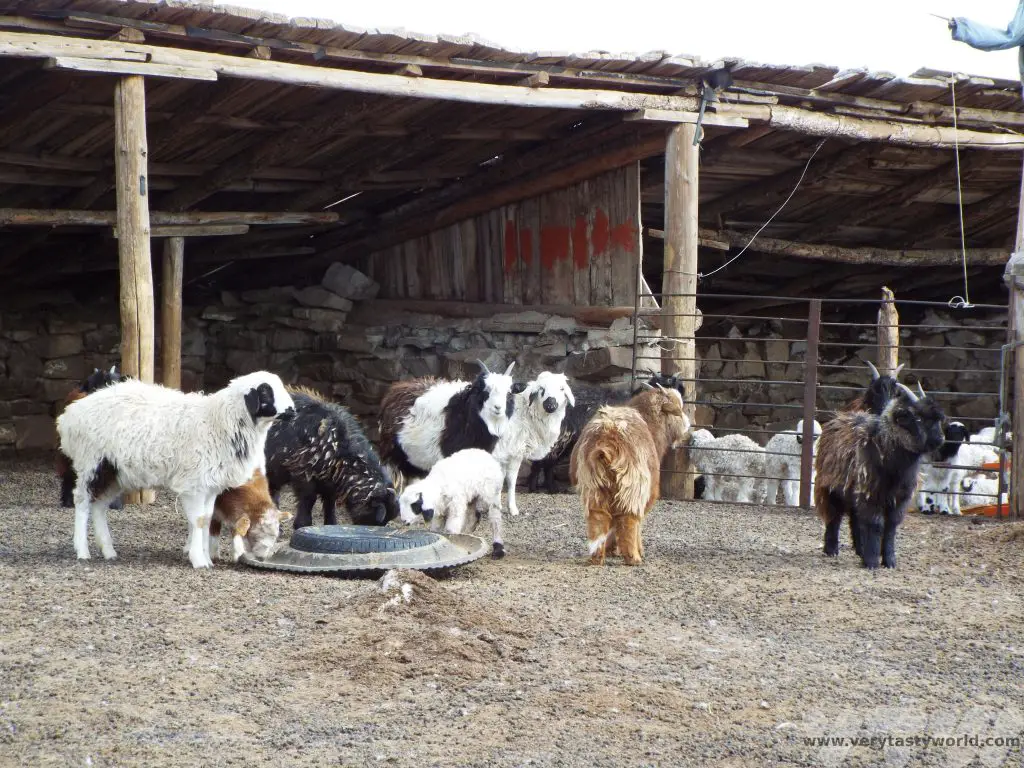
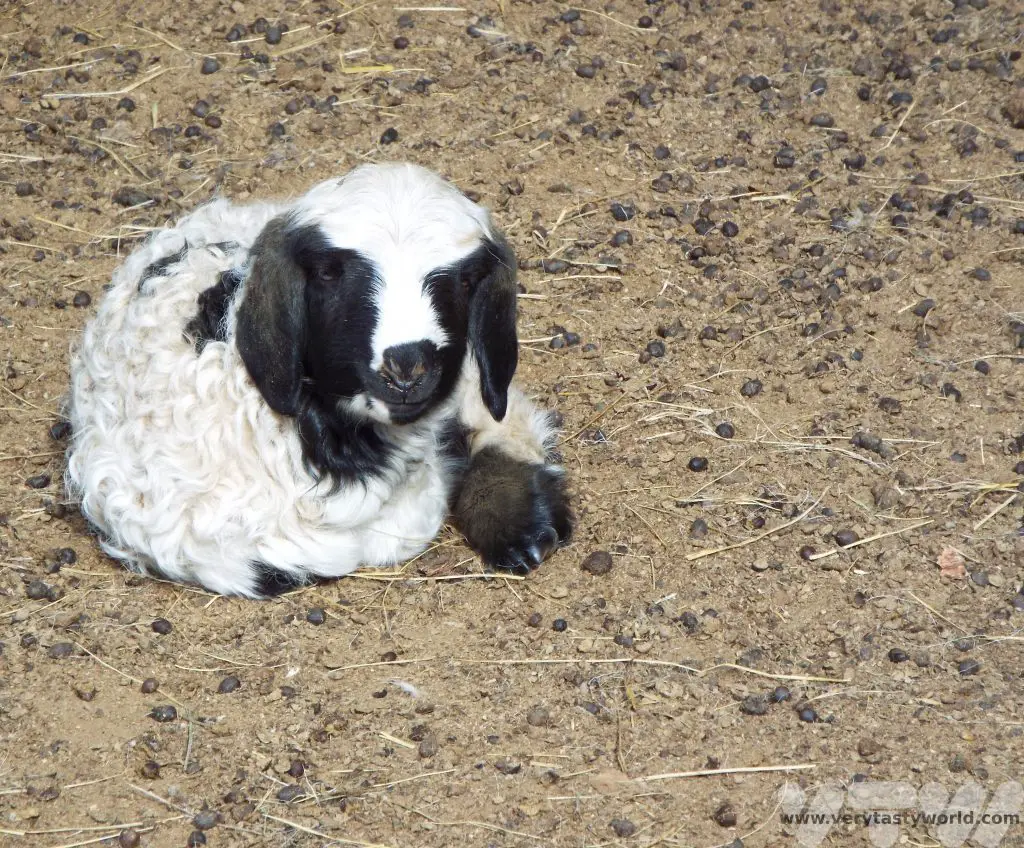

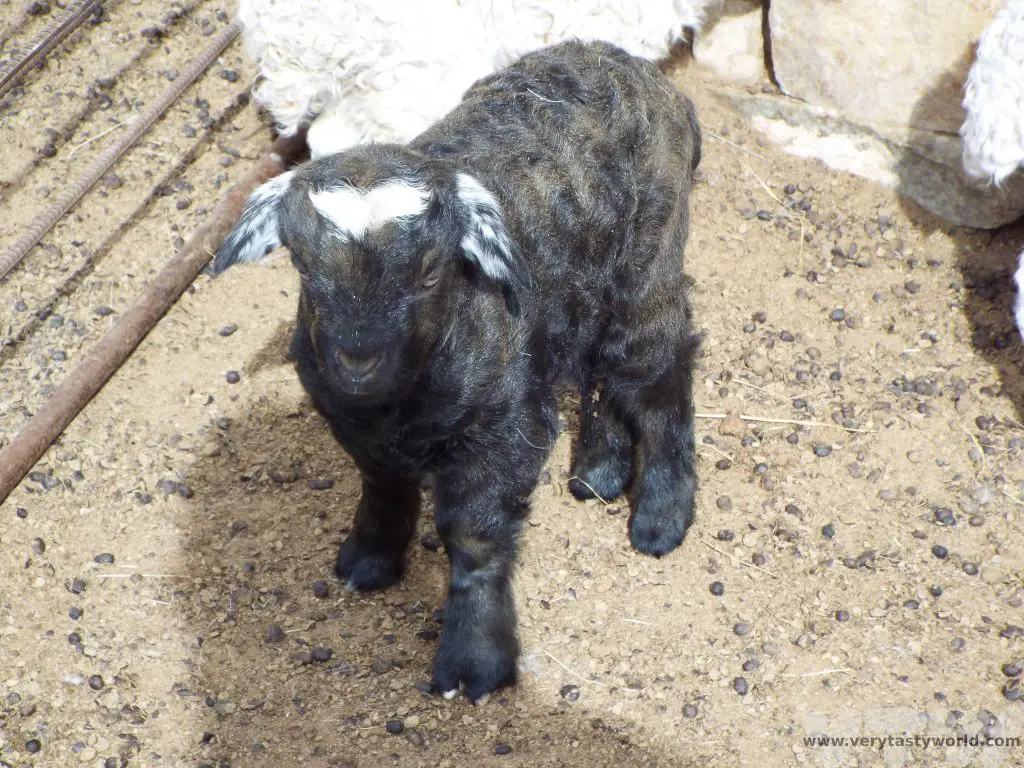
Once the lambs had been separated the older members of the herd were sent out to pasture. They were left to roam together and would be brought back via quad bike at the end of the day.
Then it was time to clean out the pens. We needed to rake through the wool and hairs amidst quite a significant amount of poo and gather it up.
Then we sent the teenagers out to pasture.
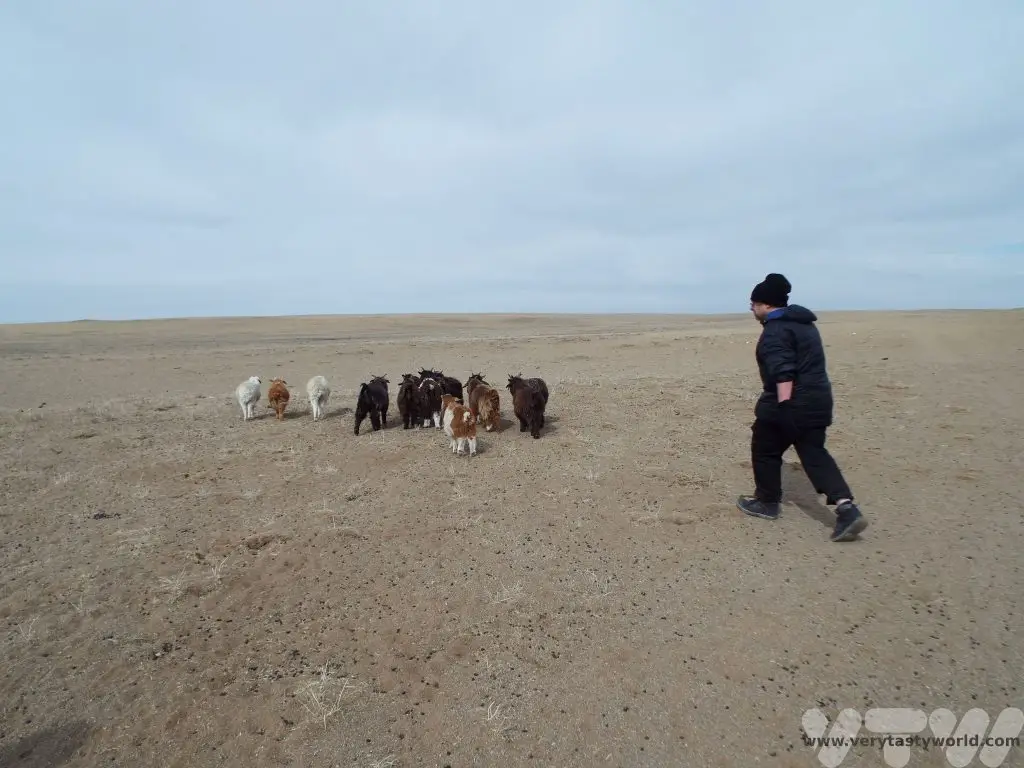
Next job was to water the cows. We drove to the nearest well which was several kilometres away. In the Gobi Desert there are precious few roads and we were constantly amazed at how the local people knew how to navigate across vast areas of desert and still find their way to the destination. The cows also have this in-built navigational ability as they were already waiting for us.
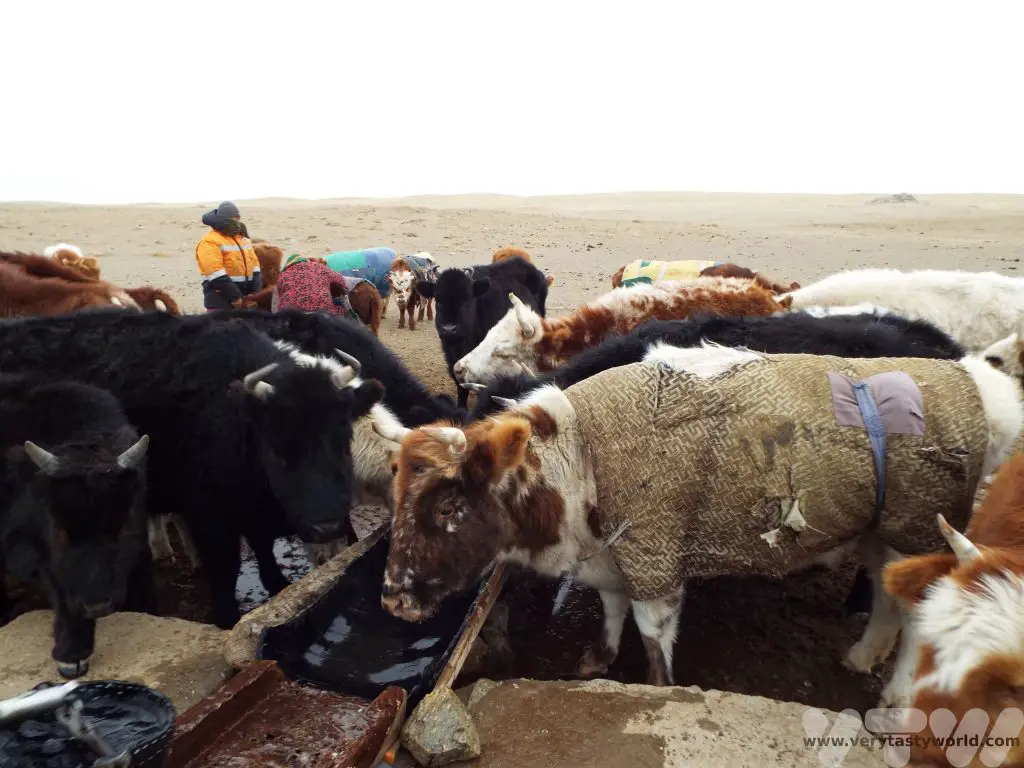
The sides of the well were frozen but the water was fine. It was a manual process to draw the water using a bucket.
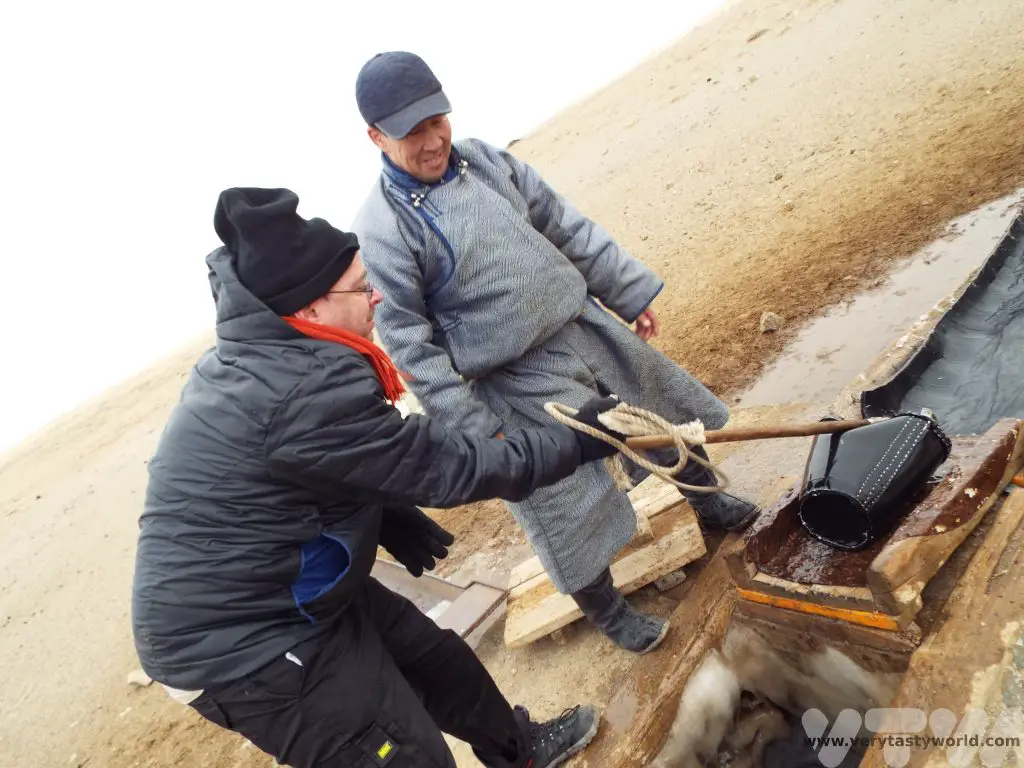
The water is pure and can be consumed without filtration. As the ger didn’t have running water we collected some for ourselves as well.
On our return to the ger camp, we needed to collect dung for the stove. The family have a dung storage area, located away from the main ger camp where the animal poo is collected and dried out. The family have a lot of animals which produce a lot of dung.
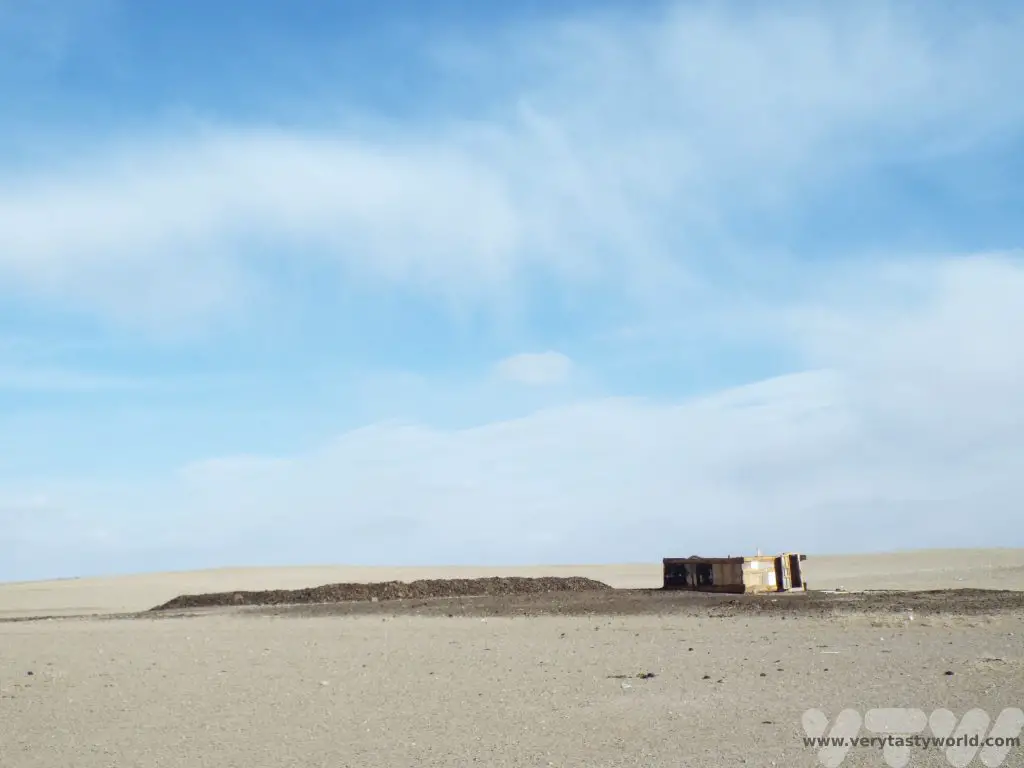
Cooking Dinner In The Gobi Desert In Mongolia
Then it was time to make dinner so we headed back to the ger. The stove is really adaptable and each are pretty much identical in terms of size and construction. Family kitchens will have various additional parts – a deep stewing pot or hob – which are interchangeable and offer a variety of cooking methods.
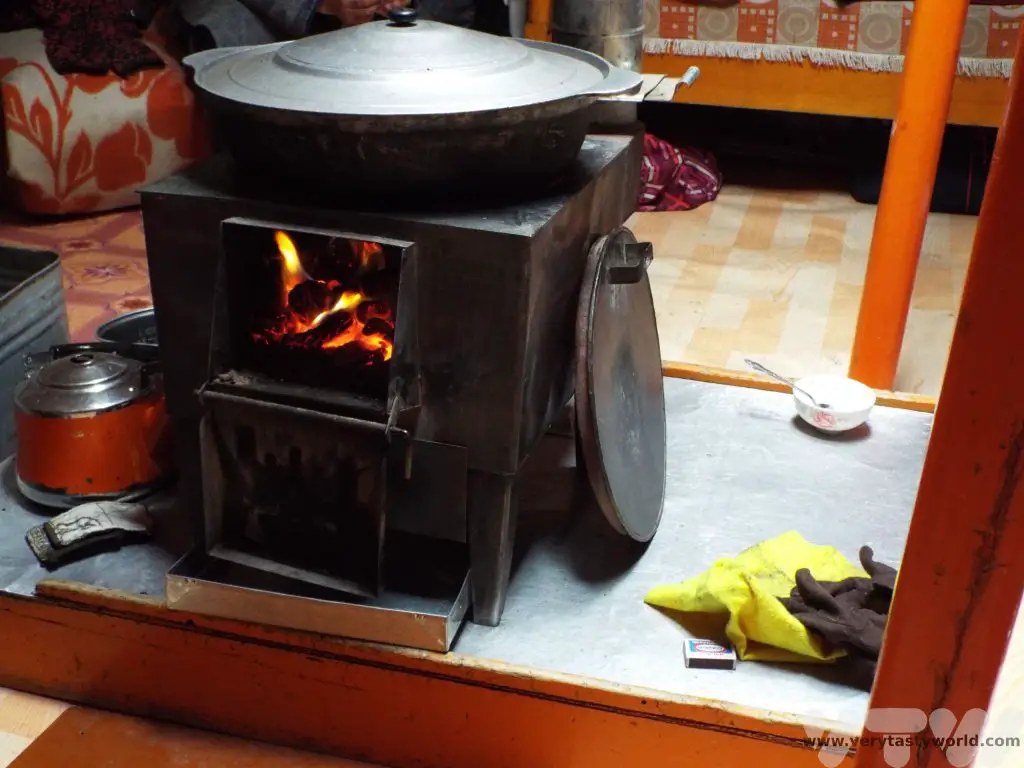
Tsuivan is a rustic dish, simple to make but it is delicious and filling. It comprises Mongolian noodles, vegetables and meat. First of all we set about making the noodles.
We made a dough using plain flour and water, kneading it until it had a soft, pliable texture and then let it rest for a few minutes.
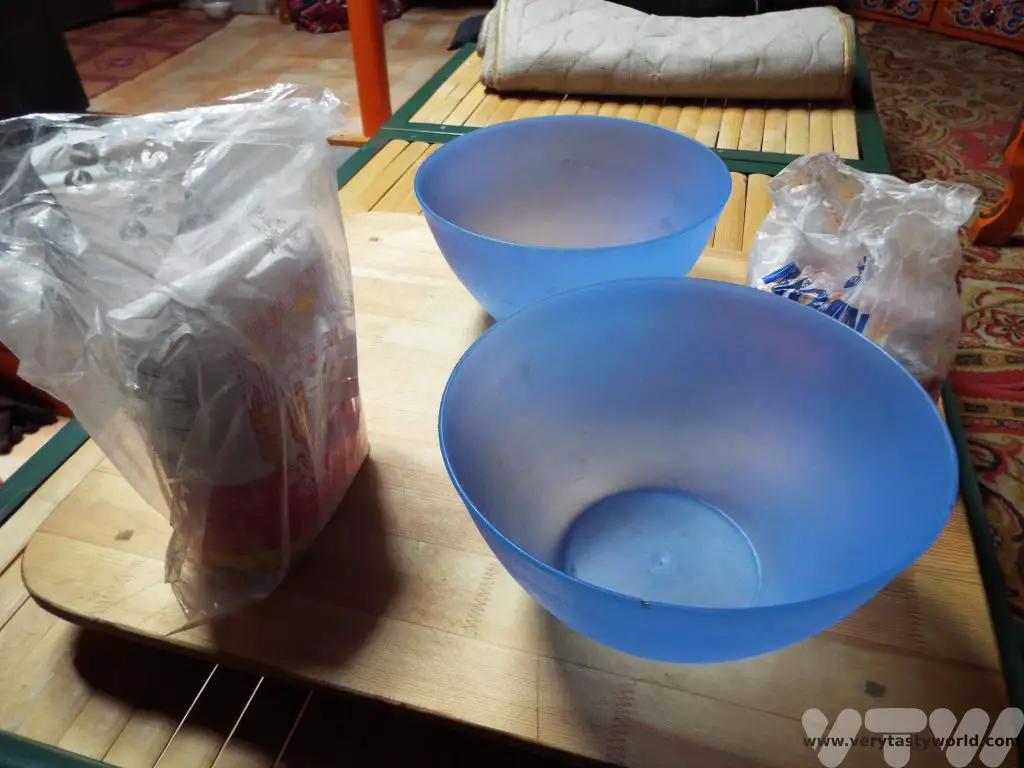
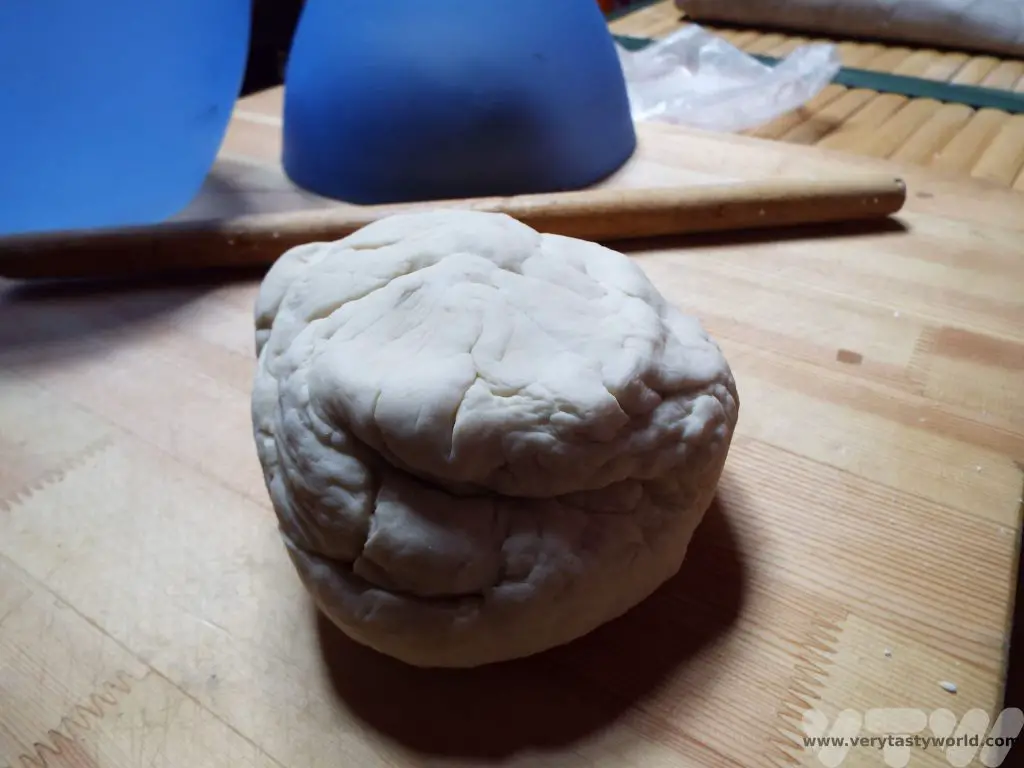
We then took a golf ball sized ball of dough and rolled it out very thinly, repeating the process until all the dough had been rolled into thin discs. The shape didn’t matter but we did try to make them as thin as possible using a rolling pin.
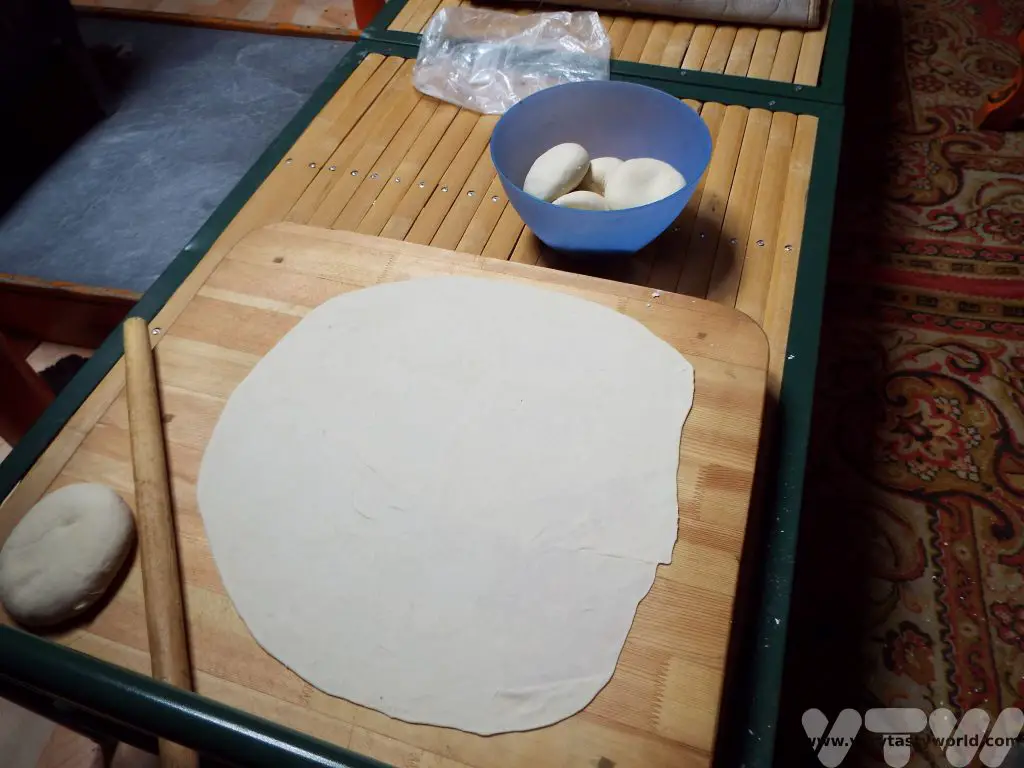
The noodles-in-waiting then need to be cooked briefly. They grill on the hob of the stove until lightly toasted – just for a few minutes, then they are turned over and the other side grilled.
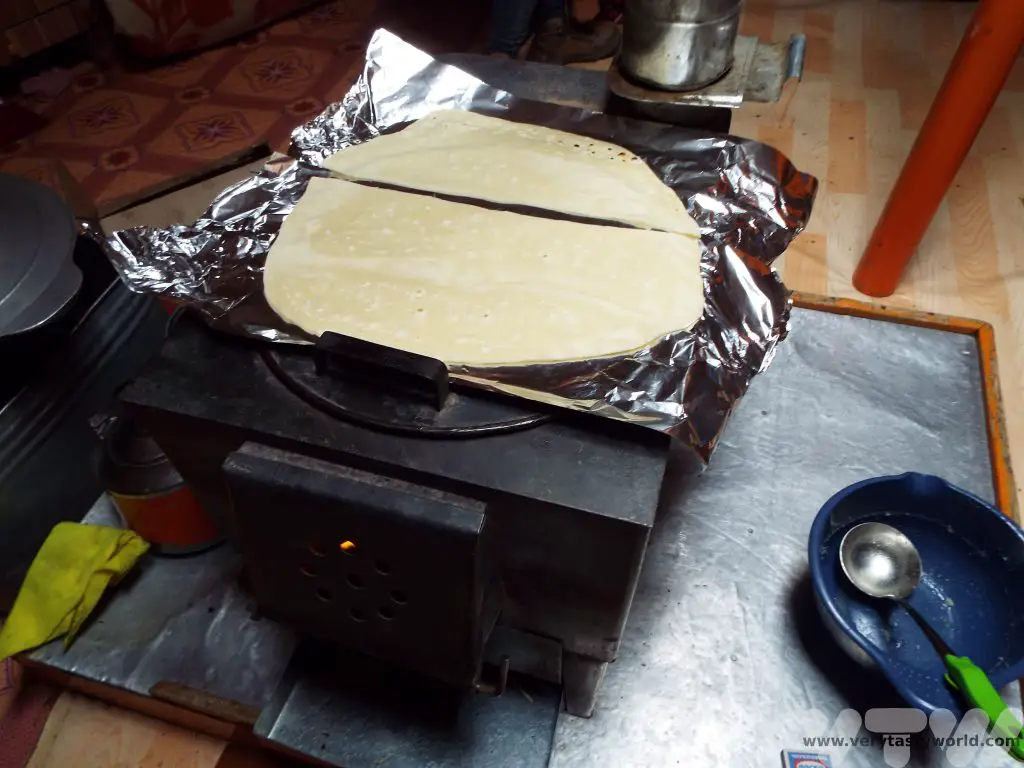
In the meantime we prepared some mutton and vegetables – potatoes, carrots and onions – by chopping into chunks. The stove was so versatile that the same heat source can be used as a pot or a griddle. The hob of the stove was then switched for the cooking pot – which fits over the fire perfectly – and the meat browned and vegetables added to fry in the meat juices.
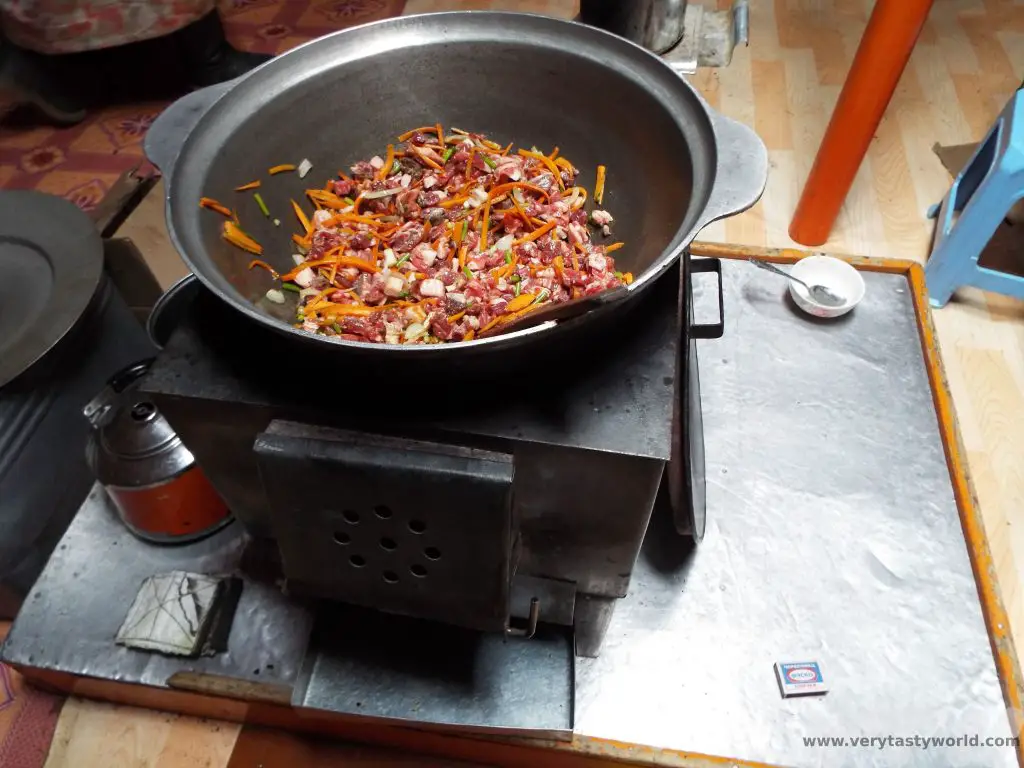
Then water is added to allow the food to stew. The seasoning was simply salt, you don’t get a variety of herbs and spices in Mongolia. Whereas we are used to eating lamb in the UK, mutton is more common across Mongolia. It has a lot more flavour than lamb and, although the meat isn’t as tender, it really benefits from being cooked for a long time over the heat. The taste of the mutton was so good that it meant we didn’t really need additional seasoning.
While the mutton and veg were stewing we stacked the toasted dough and cut it into thin noodles.
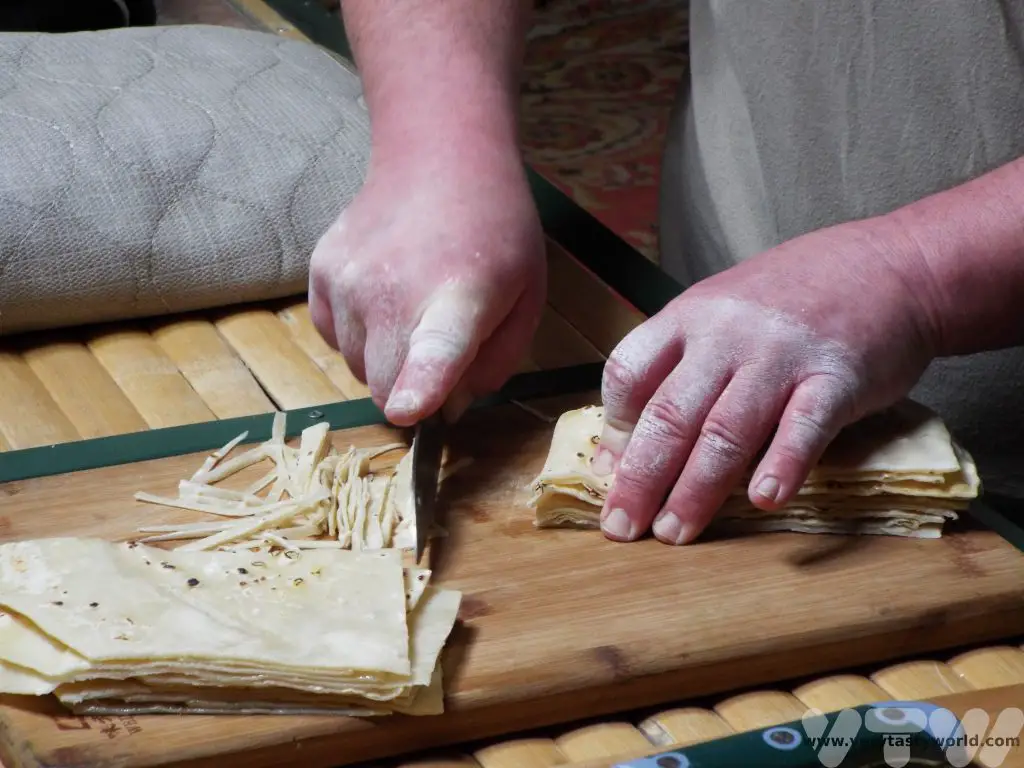
These were then laid across the meat and veg and steamed in the heat until they were soft.
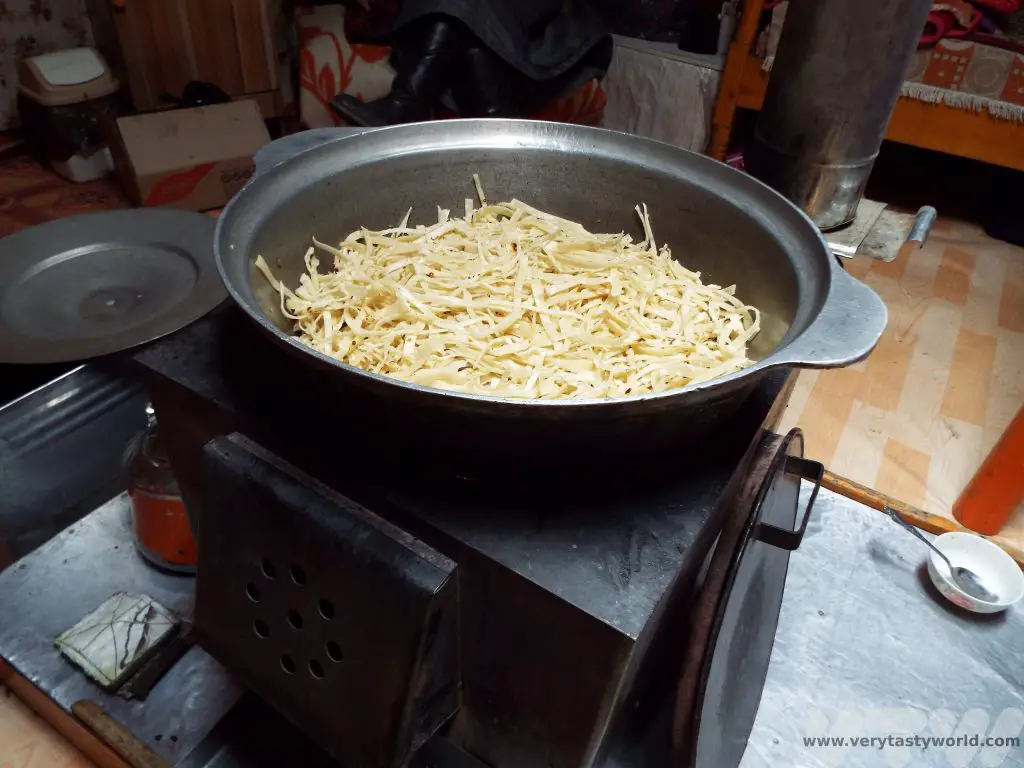
Time to serve up. It’s a delicious meal. We all ate together.
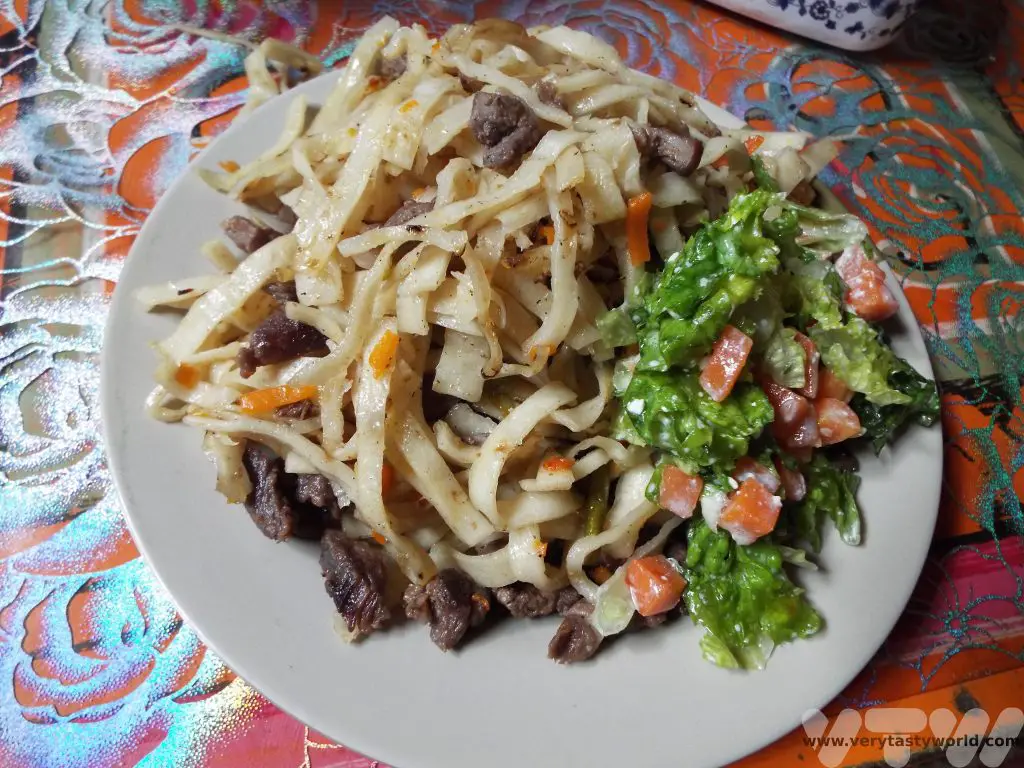
After our hearty dinner we sat down with the family and played silly card games. The family also offered some of the last of their airag, an alcoholic fermented mare’s milk drink. We had been keen to try it, although we knew we were visiting outside the mare milking season, so considered ourselves to be very lucky that the family were willing to share the remnants of last year’s brew with us.
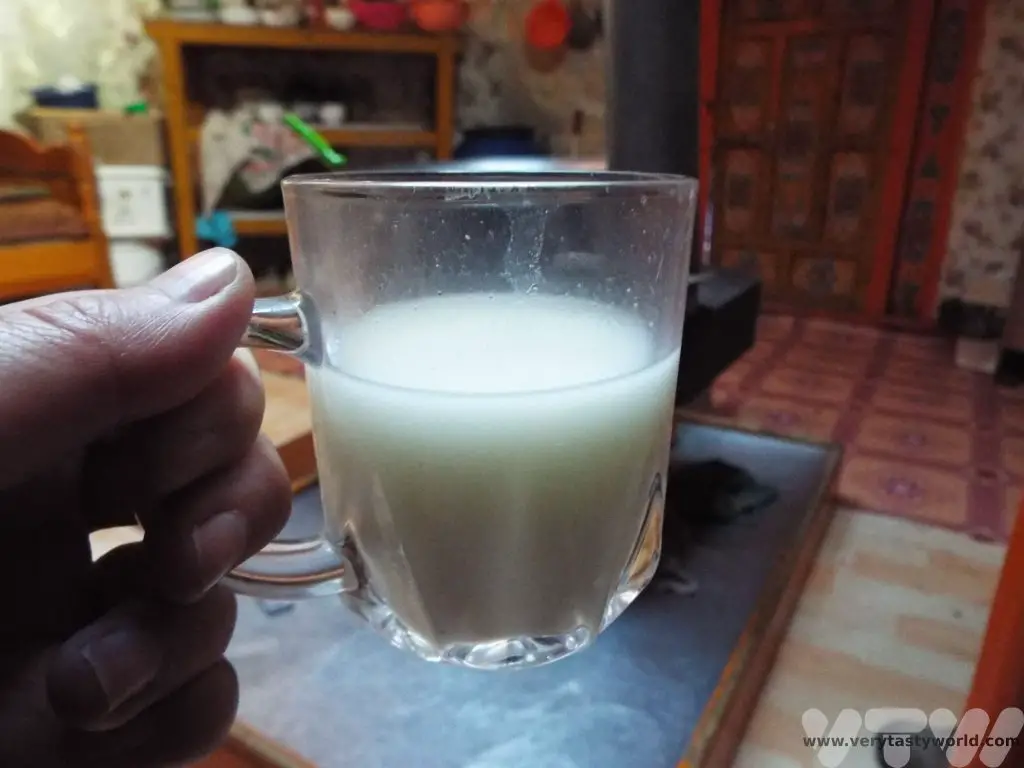
Any fear of the unexpected that we had felt that morning had vanished. Yes, it had been challenging to experience a lifestyle so very different to ours but it was a fantastic challenge. We were very privileged to have joined this welcoming family and to have shared a day in their lives. They very kindly told us that we had genuinely helped out and had done a good job cleaning the pens.
And so to bed. But before we hit the sack we were joined by this little one.
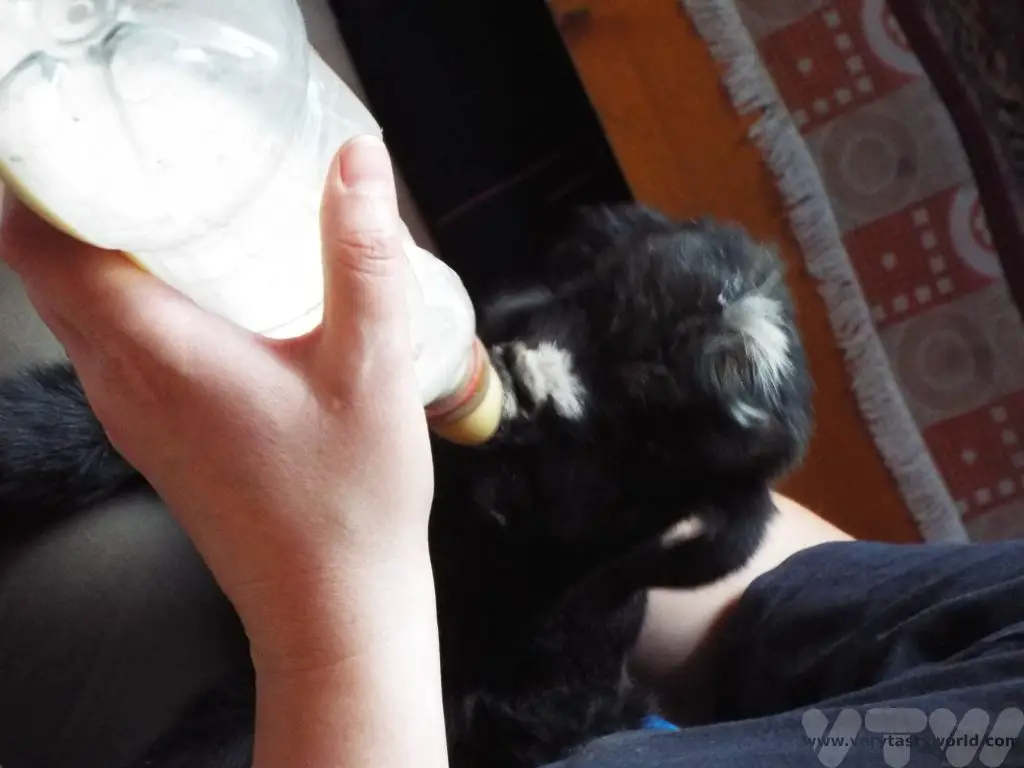
She was just 10 days old and our hosts decided that the overnight temperature was going to be too low for her to survive outside. So we fed her and let her prance around the ger. She bleated in the most delightful way throughout the night.
Related Posts You May Enjoy
A Mongolian Yurt – Anatomy of a Ger
One of the lovely things about travelling to Mongolia is staying in gers, either with families who were kind enough to share their homes with us or at specially designed tourist camps. A ger (also known in Western countries as a Mongolian yurt, although ger is the correct Mongolian term) are traditional round tents used as dwellings throughout Mongolia. The amazing thing about them is that they can be taken down and put up within a couple of hours. The construction uses no nails or fixings – the wooden poles interlock and remain sturdy and solid.
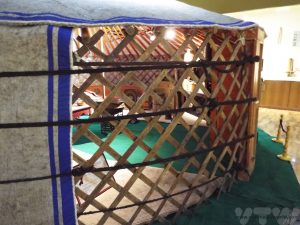
The national museum of Mongolia in Ulaanbaatar helpfully has a model to show a ger’s construction.
The door of the ger always faces south. You have to remember to duck when entering – it’s probably a rare visitor who doesn’t bash their head at least once when staying in gers!
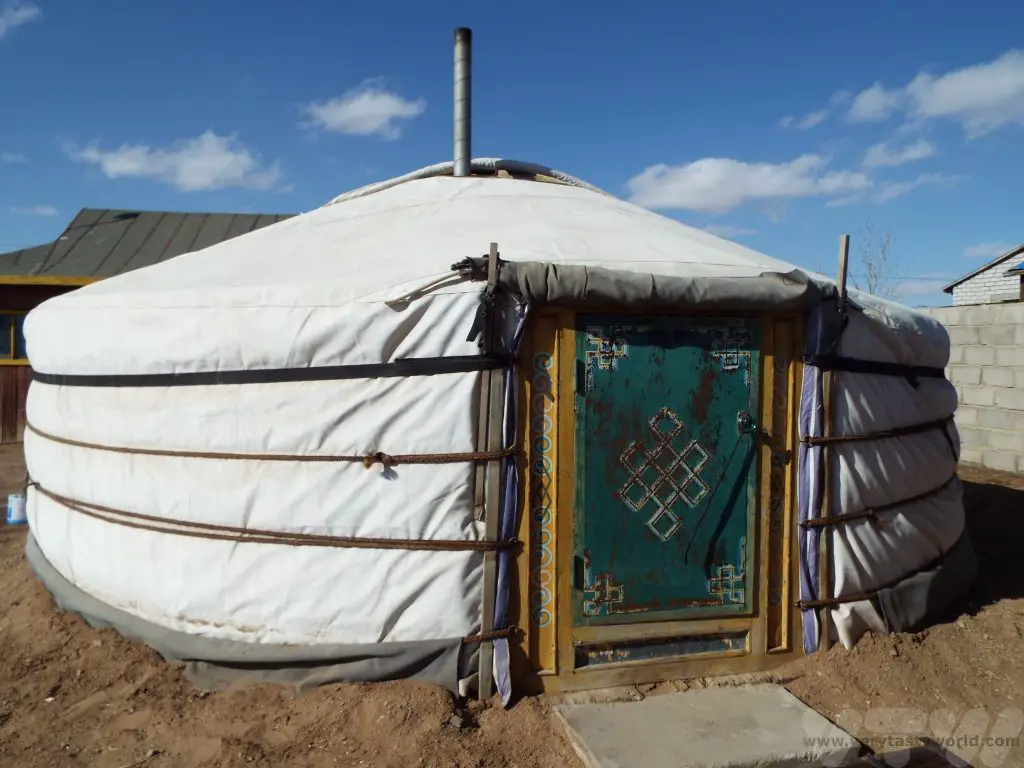
Most locals don’t knock before entering the ger and shoes remain on. Whenever we visited a family we were invited to join them and were introduced to all the family members over a cup of milk tea or sometimes a shot of vodka. We were always welcomed warmly with big smiles at every place we visited.
In winter, temperatures outside can drop to -30 degC. We visited in spring so night-time temperatures were a relatively balmy -15 degC – which was still very, very cold! The fuel used by the family varies depending on what is available – coal burns more slowly than wood which burns more slowly than dung.
The Heart Of The Home
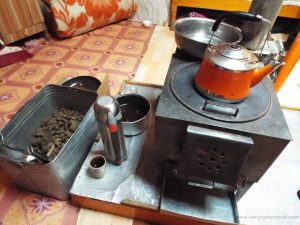
The centre of the ger is the stove. It really is the heart of the home, used for both cooking and heating. You need to be aware of the chimney as it’s located in the centre of the ger and will get very hot.
To the left of the door is the kitchen area. Shelves contain pots and pans as well as cooking utensils. Many of the pots are specifically designed to be used directly on the stove and can be used interchangeably. It’s a very efficient system.
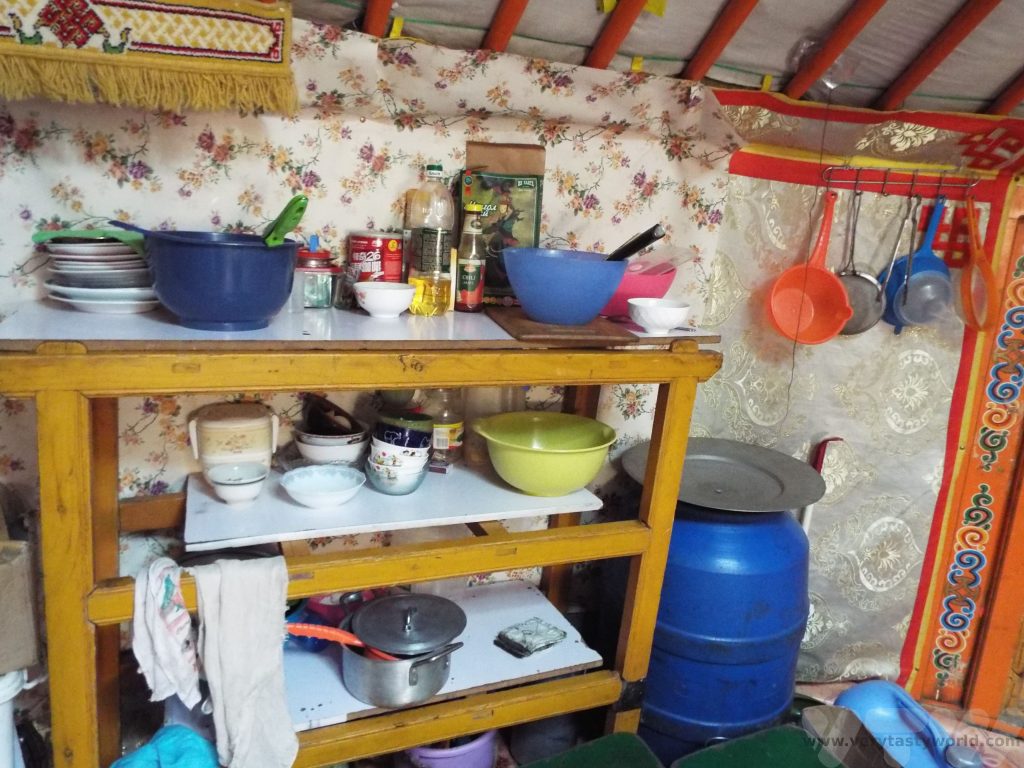
The blue barrel contains water, drawn from the nearest well.
To the right of the door is the washing area. There is no running water available but the little plastic vessel can be filled from the main water barrel and the tap opened.
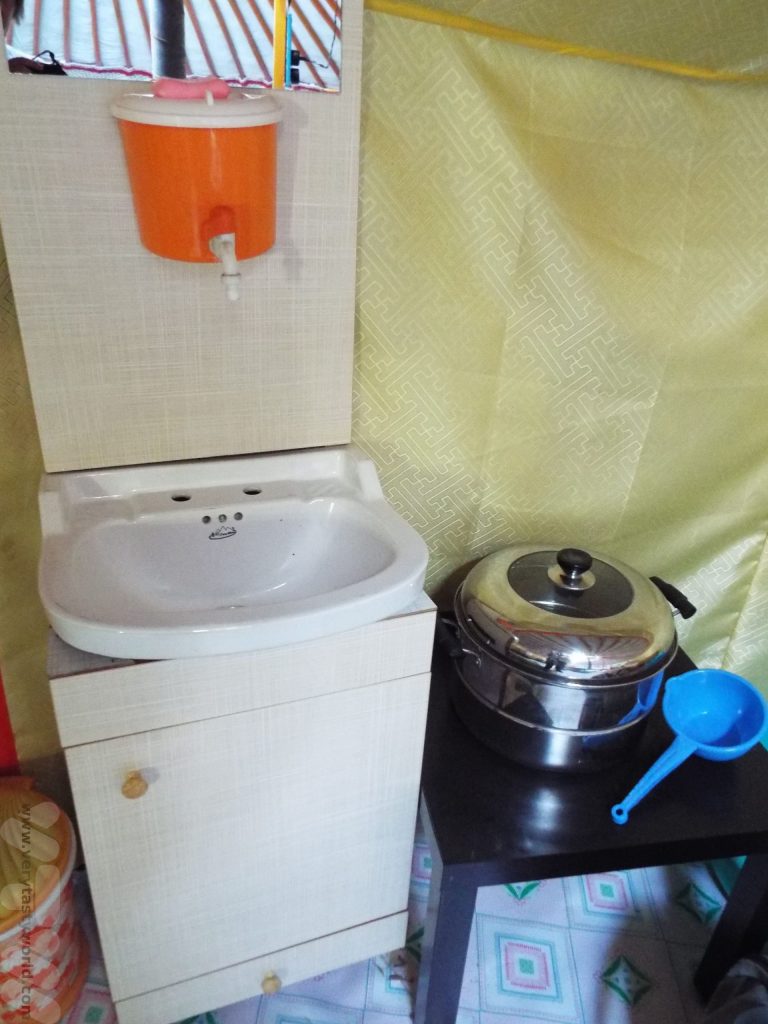
Be careful not to waste water though. If you want water in the Gobi desert you have to go to the nearest well, which can be several kilometres away.
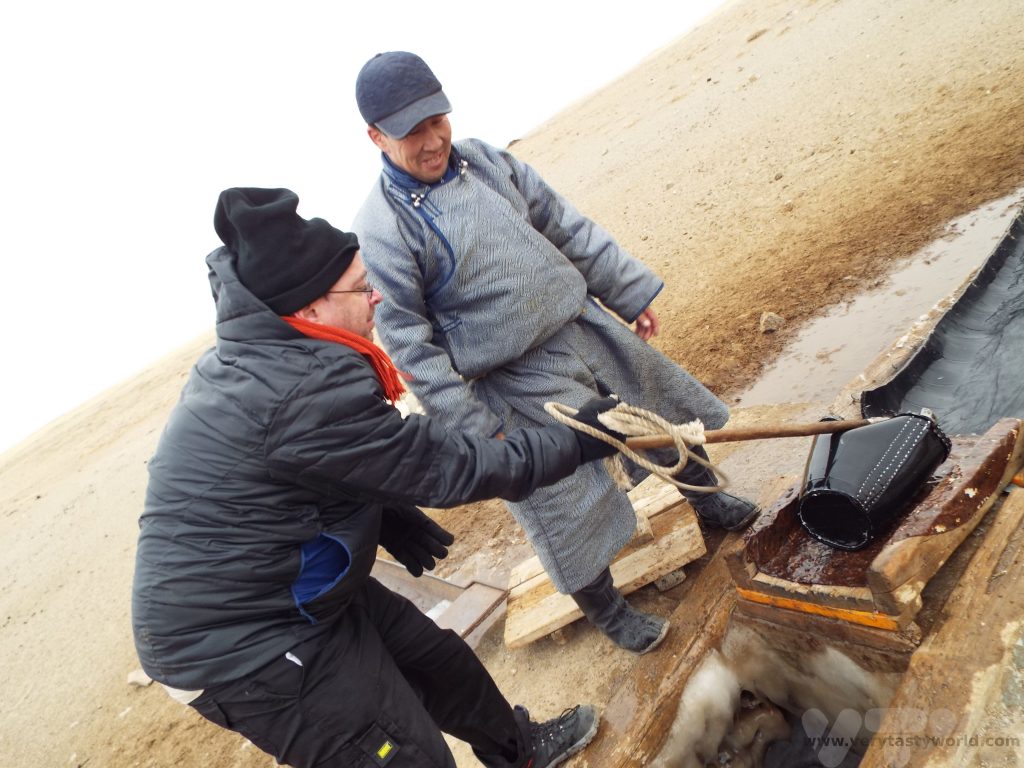
The water is pure and can be drunk directly with no filtration needed. It tastes good.
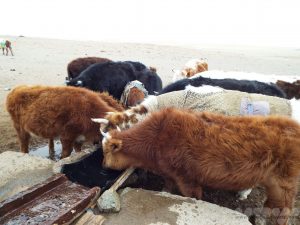
This well was used not only to provide water for the family, the local cows were also waiting for a drink.
Sleeping In A Mongolian Yurt – A Ger
Beds and storage areas line the circumference of the ger. There will be a low table with stools next to the stove. Beds double as a seating area – it’s perfectly fine to sit on someone’s bed. Blankets and clothes can be stored underneath. You can hang your coat or dry any laundry by hanging clothes in the rafters. Family homes also had furniture such as chests of drawers and dressing tables.
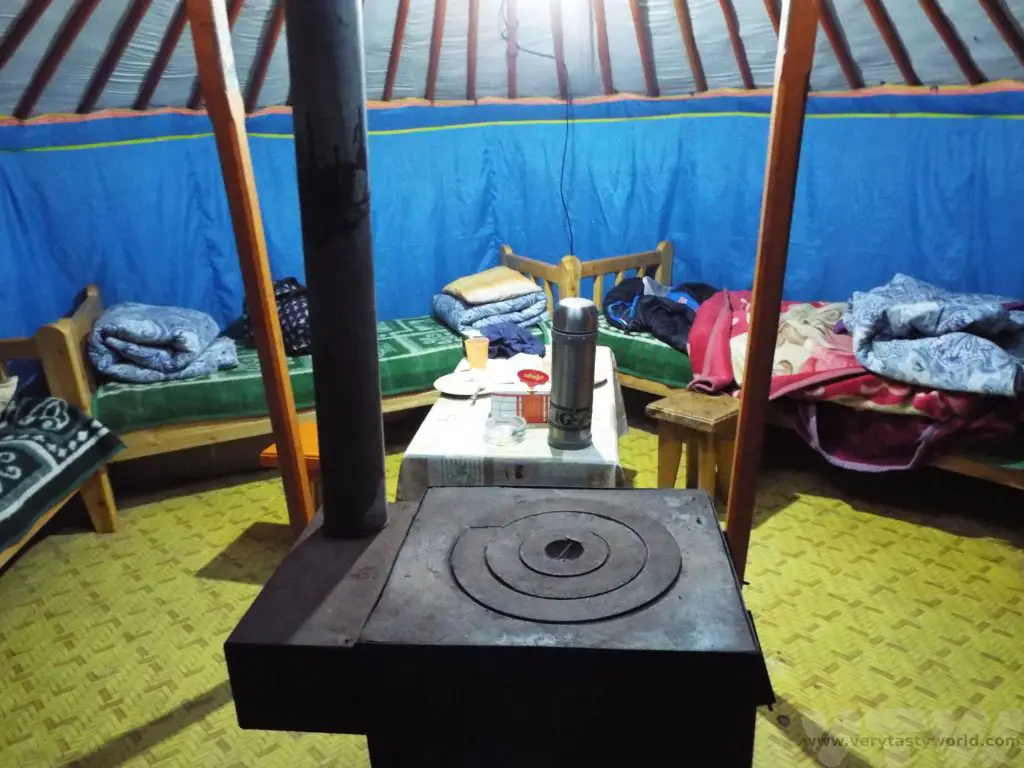
Of course there is a need for a toilet. The facilities are usually a basic long drop loo, that is, a hole in the ground with a couple of planks across it to stand on, located some 50m from the ger. When answering the call of nature you are surrounded by, well, nature.
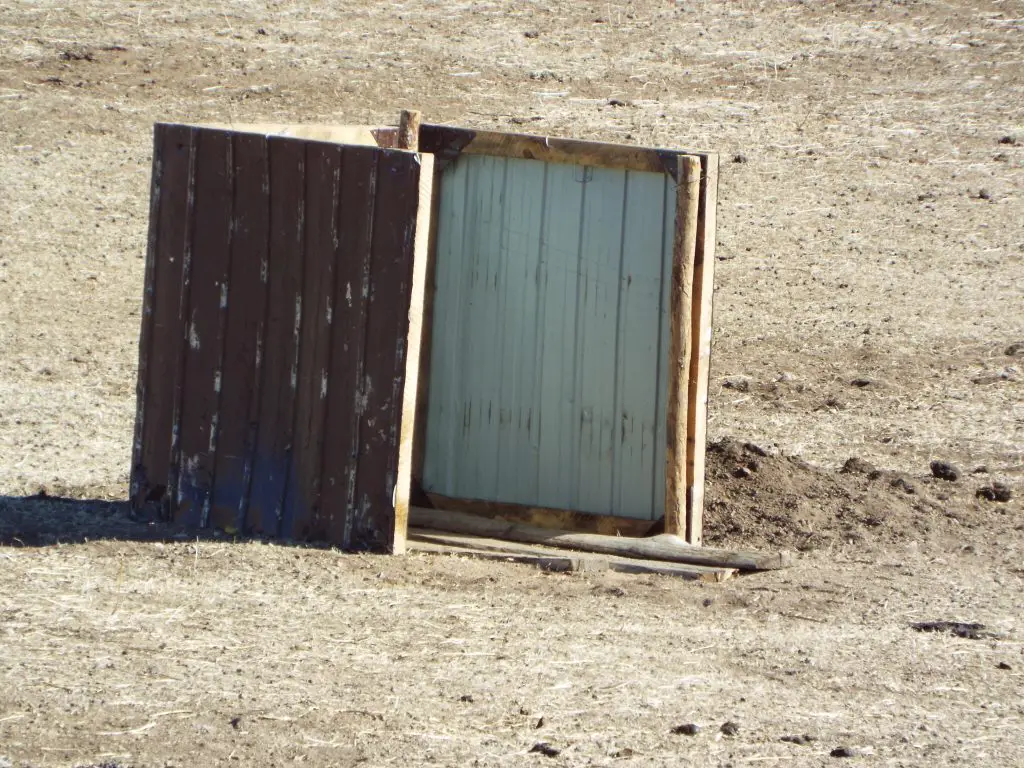
If you want a shower you will have to go to the local town. There are shower houses available for locals to use. We had just three showers in eleven days and were surprised to discover that it’s quite liberating having greasy hair and simply not feeling the need to shower every day. We’d have a quick wash down with wet-wipes on non-shower days (making sure to dispose of them properly). The climate in Mongolia, especially in the Gobi, is very dry – so the heat of the summer and cold of the winter are mitigated by the lack of humidity.
In springtime, while daytime temperatures can be quite mild, it drops significantly at night. The ger will be toasty warm while the stove is lit, but it will go out and then it’s time to bundle up – thermals, blankets, sleeping bags – just pile them on.
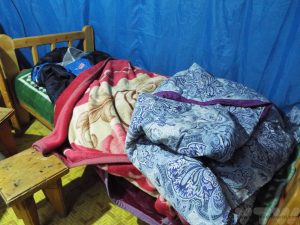
The host family will come in in the morning and start up the fire. We were pretty incompetent at getting the stove going at first but during the course our stay we eventually developed a technique that could both start and maintain the fire and we could officially deem ourselves the ‘fire-starters.’ Nomadic families make use of the dung produced by their many animals. It is dried out and used for fuel. It burns quite quickly so you need to keep an eye on the stove and top up whenever necessary.
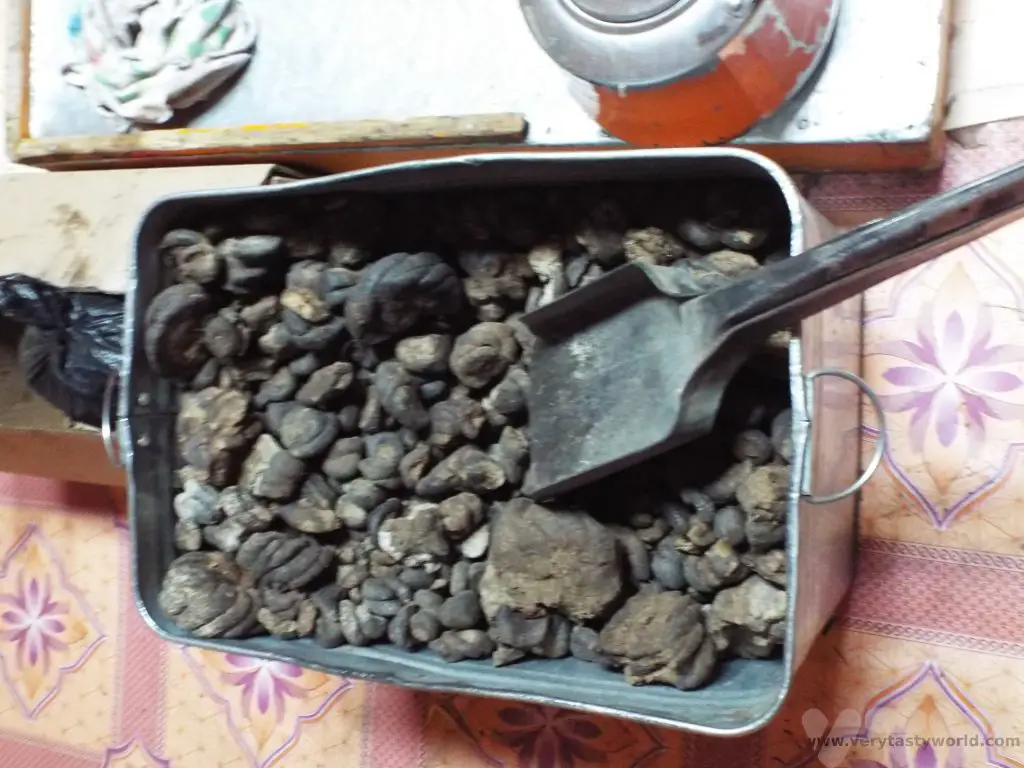
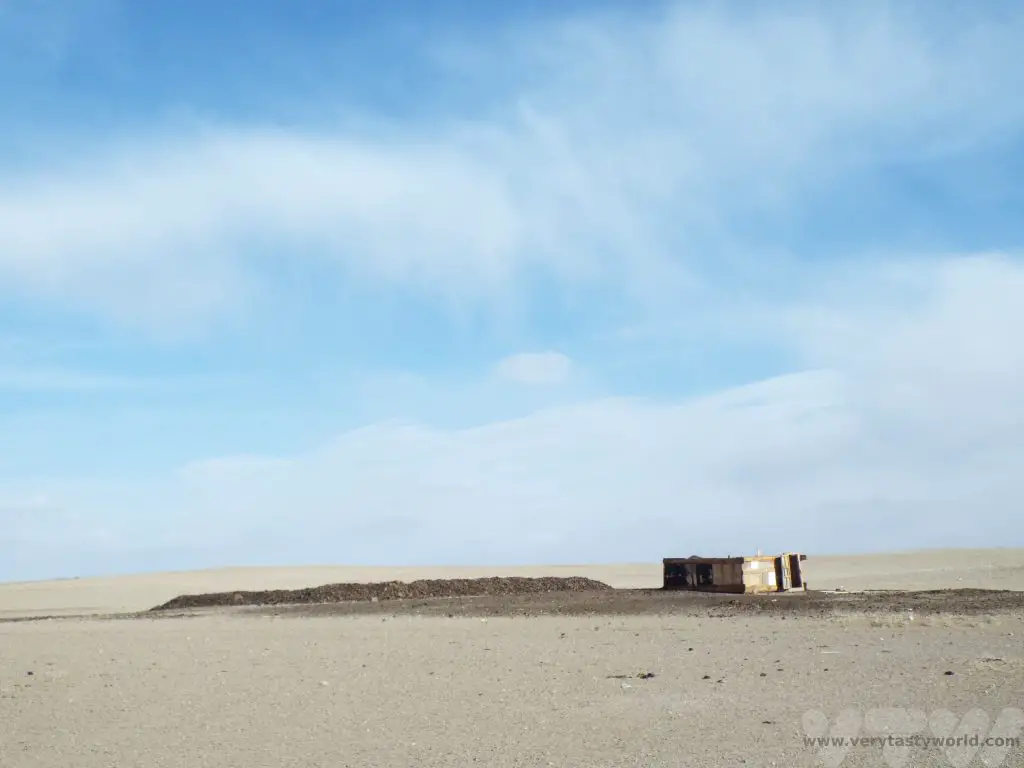
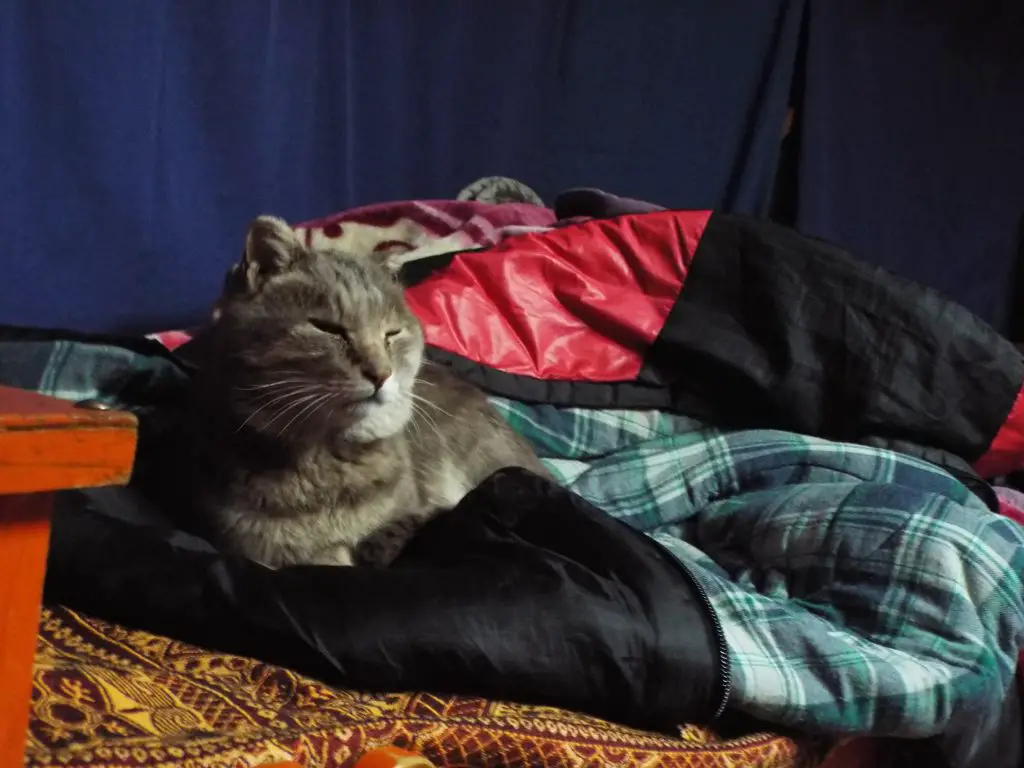
Cats are working animals in Mongolia and all our hosts found it hilarious that our little cat goes into a cattery – we described it as a ‘cat hotel’ – when we are travelling. If a local cat gets into the ger be warned, it will instantly take advantage of both the warmth and softy tourists within and will almost certainly leap onto your sleeping gear to snuggle up and look smug. You’ll be lucky to get your bed back.
